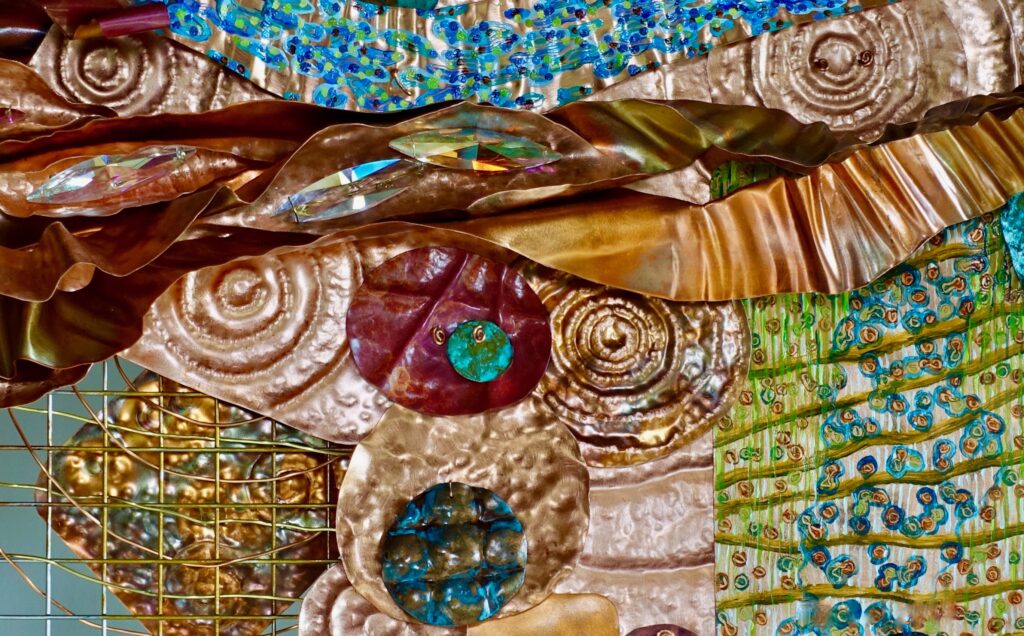 Eustis Estate
Eustis Estate
Changing Landscape
Sculpture at the Eustis Estate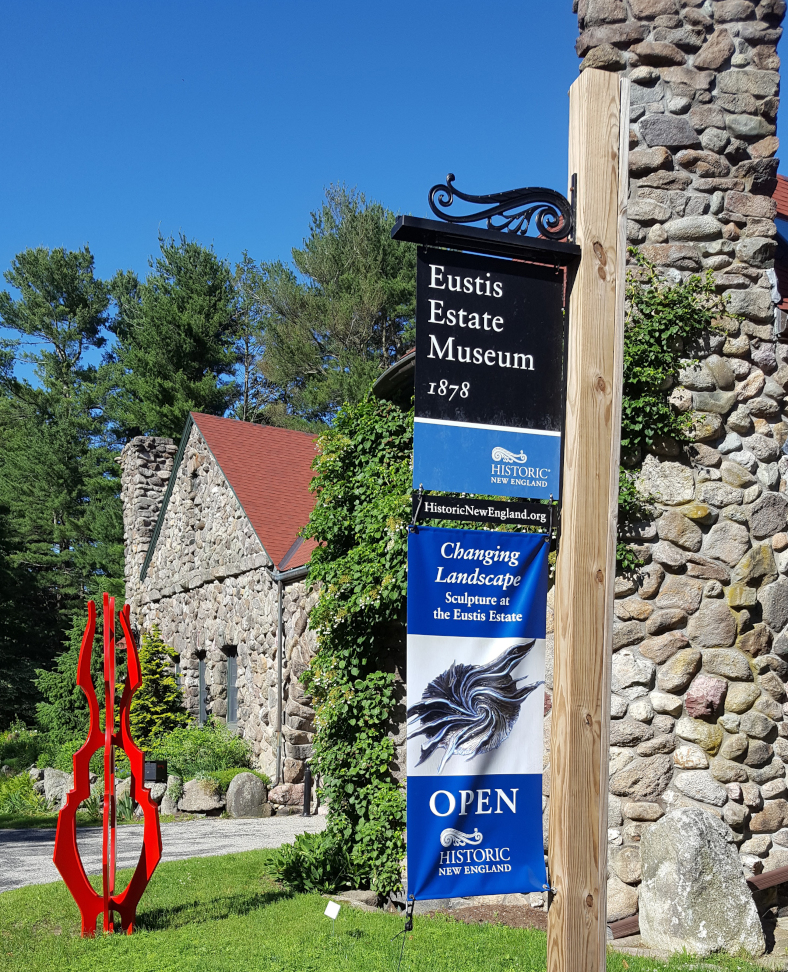
Historic New England and New England Sculptors Association (NESA) present Changing Landscape: Sculpture at the Eustis Estate, June 1 – November 3, 2019.
More than eighty contemporary sculptures by members of NESA fill the grounds and the three galleries on the second floor of the Eustis Estate. The estate, in an eighty-acre picturesque setting at the base of the Blue Hills, is the perfect backdrop for art that uses material related to landscape and the environment.
Changing Landscape explores how sculpture has an impact on its environment and enhances a visitor’s experience. The art can become an integral part of a garden, start a path, or create a focal point. Visitors can walk among the strategically placed sculptures and see their surroundings in a new way. The theme and location of the show connect the past to the future and represent Historic New England’s commitment to landscape preservation.
Below you will find additional material from the sculptors of some of the pieces in the exhibition including artist statements, process and technique information, audio and video interviews, and additional images.
Outdoor Sculpture Map
Click the dots on the map for information about the outdoor sculptures.

1. David Adilman - Backstroker
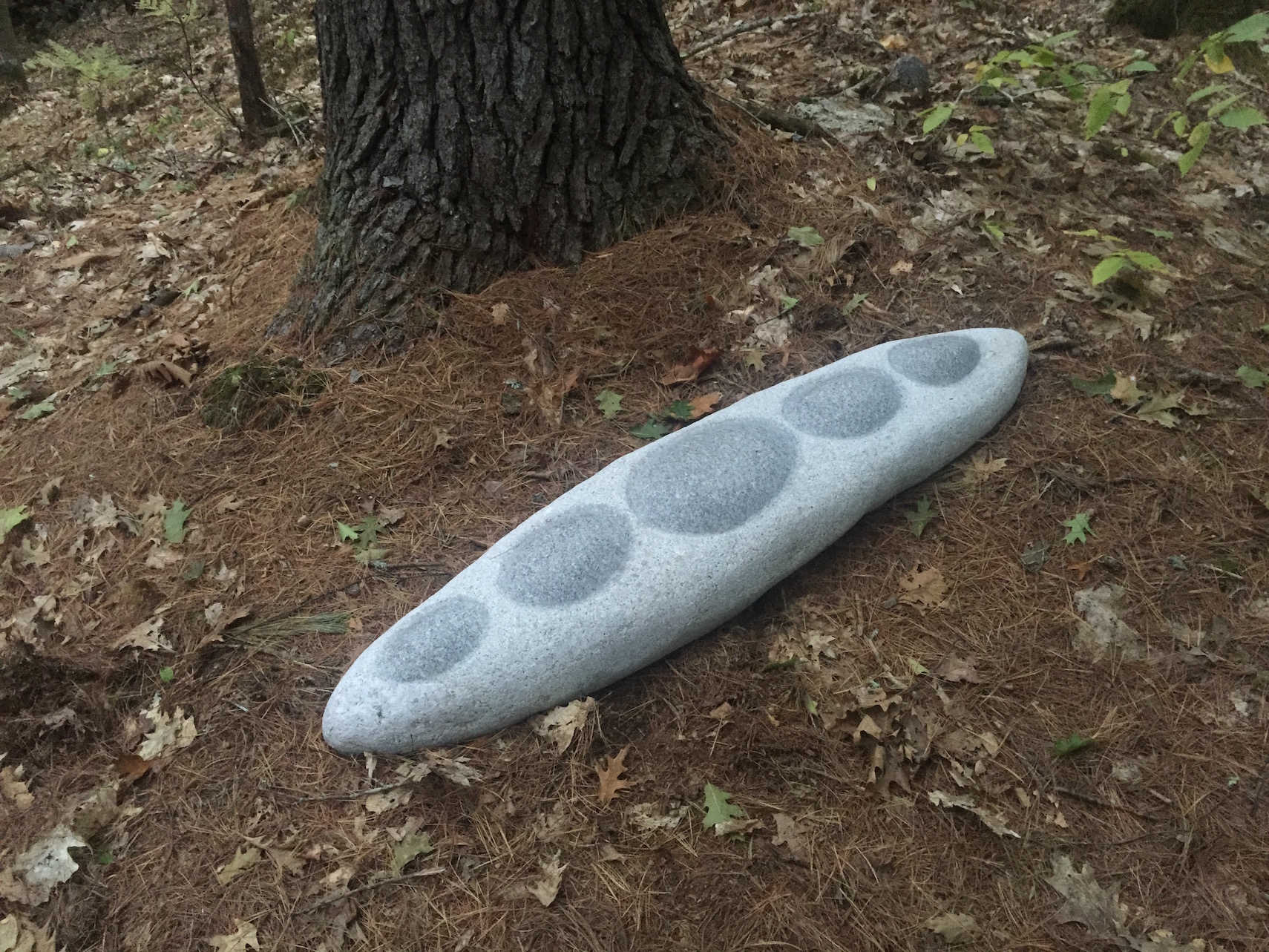
2. Anne Alexander - Guandul
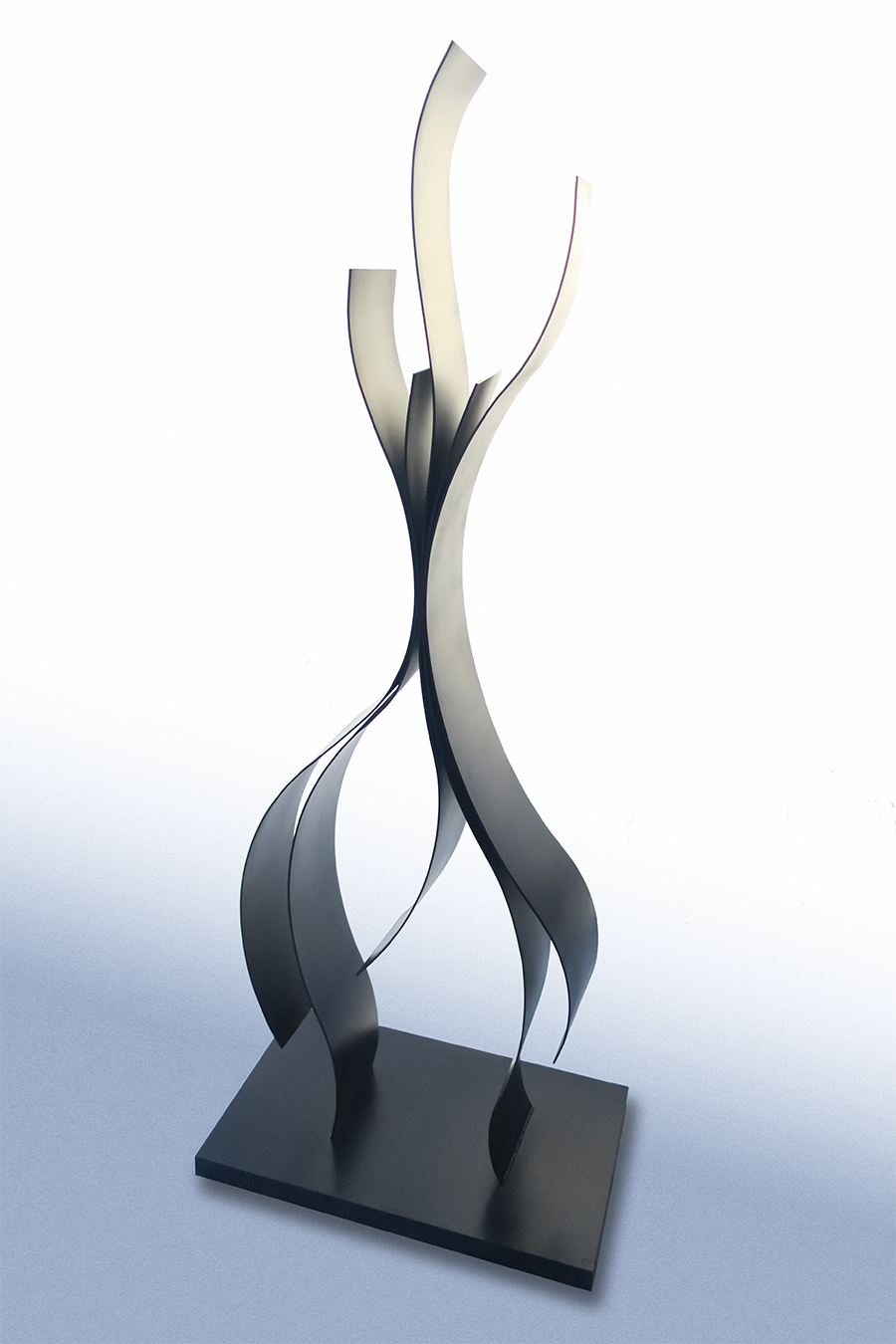
3. Craig Anderson - No 2
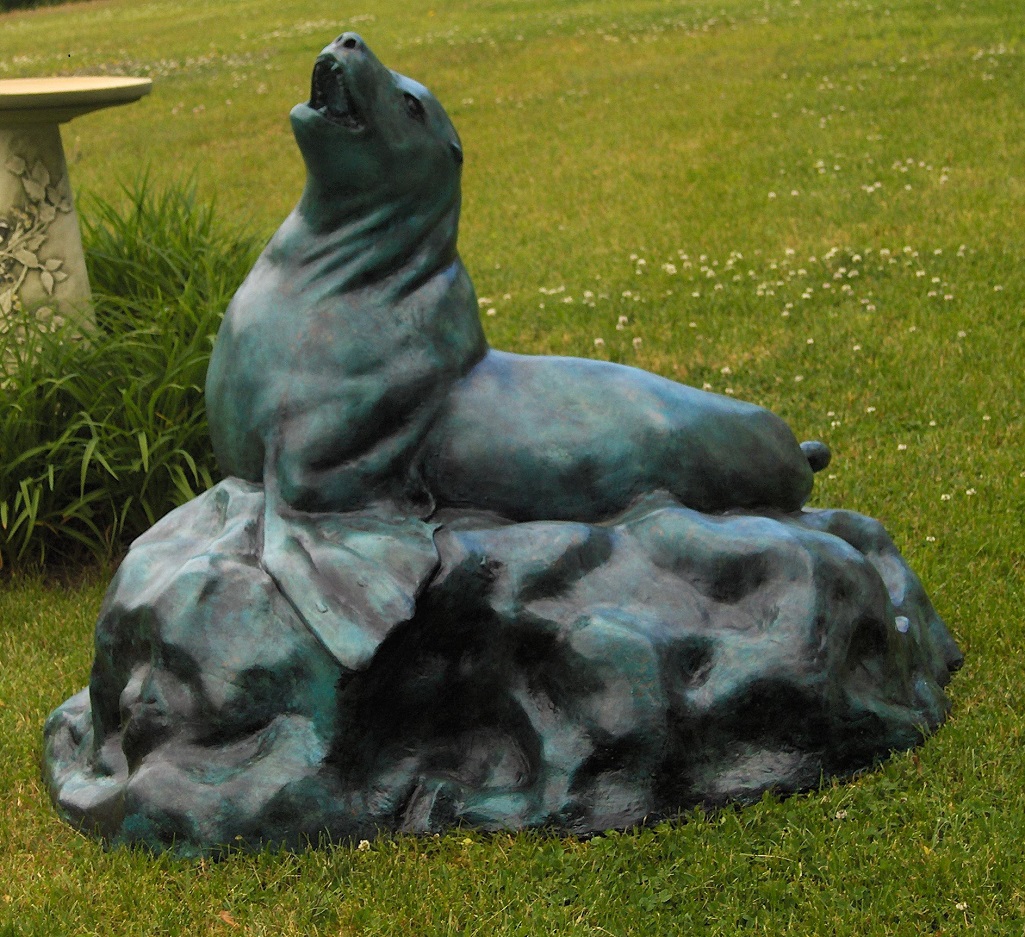
4. Serena Bates - Stellar Expectations
5. Thomas Berger - Breaking Dormancy
6. Thomas Berger - Offering
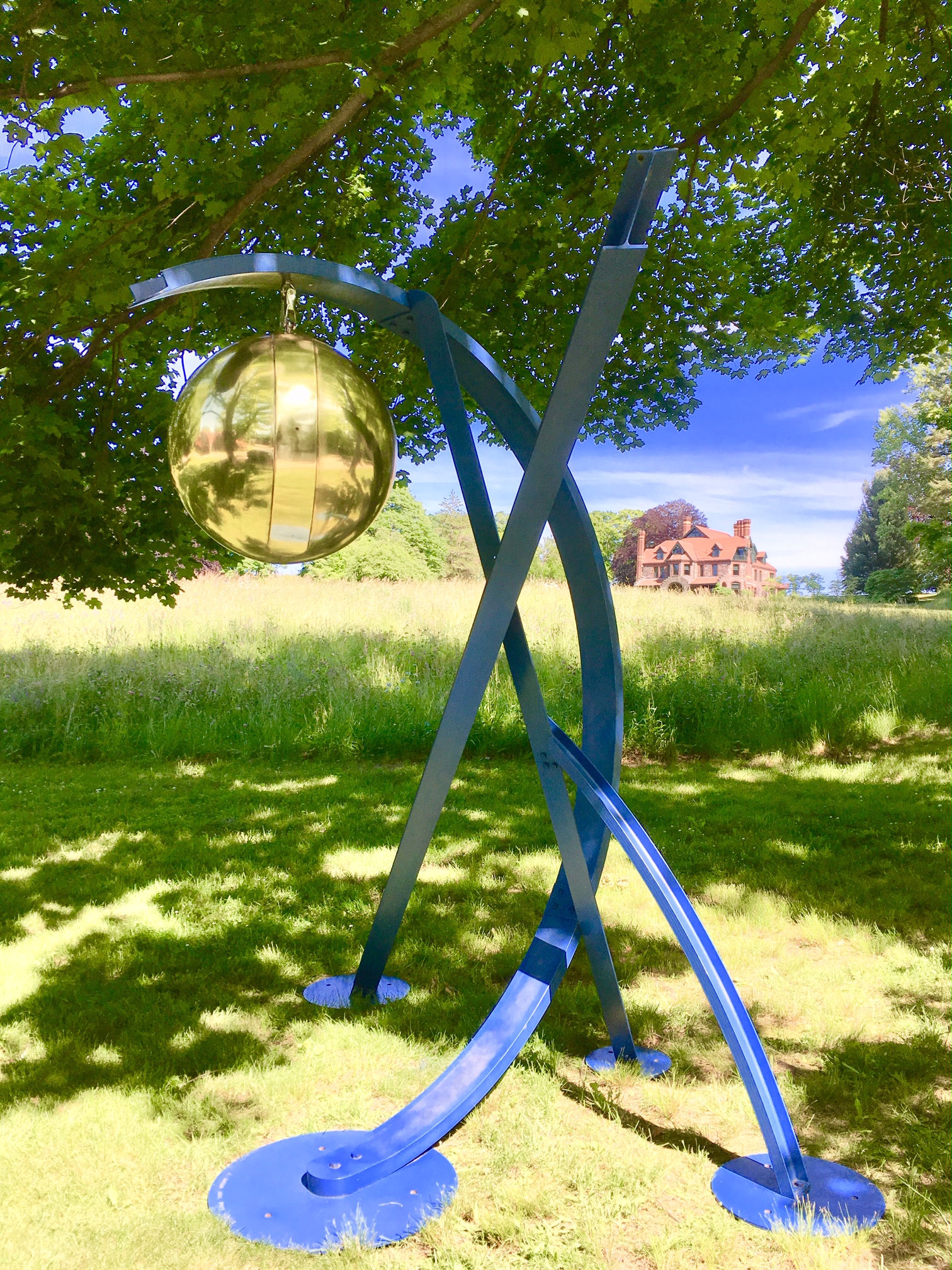
7. Gilbert Boro - Ball, Beams & Curves, IV/9 Violet Blue
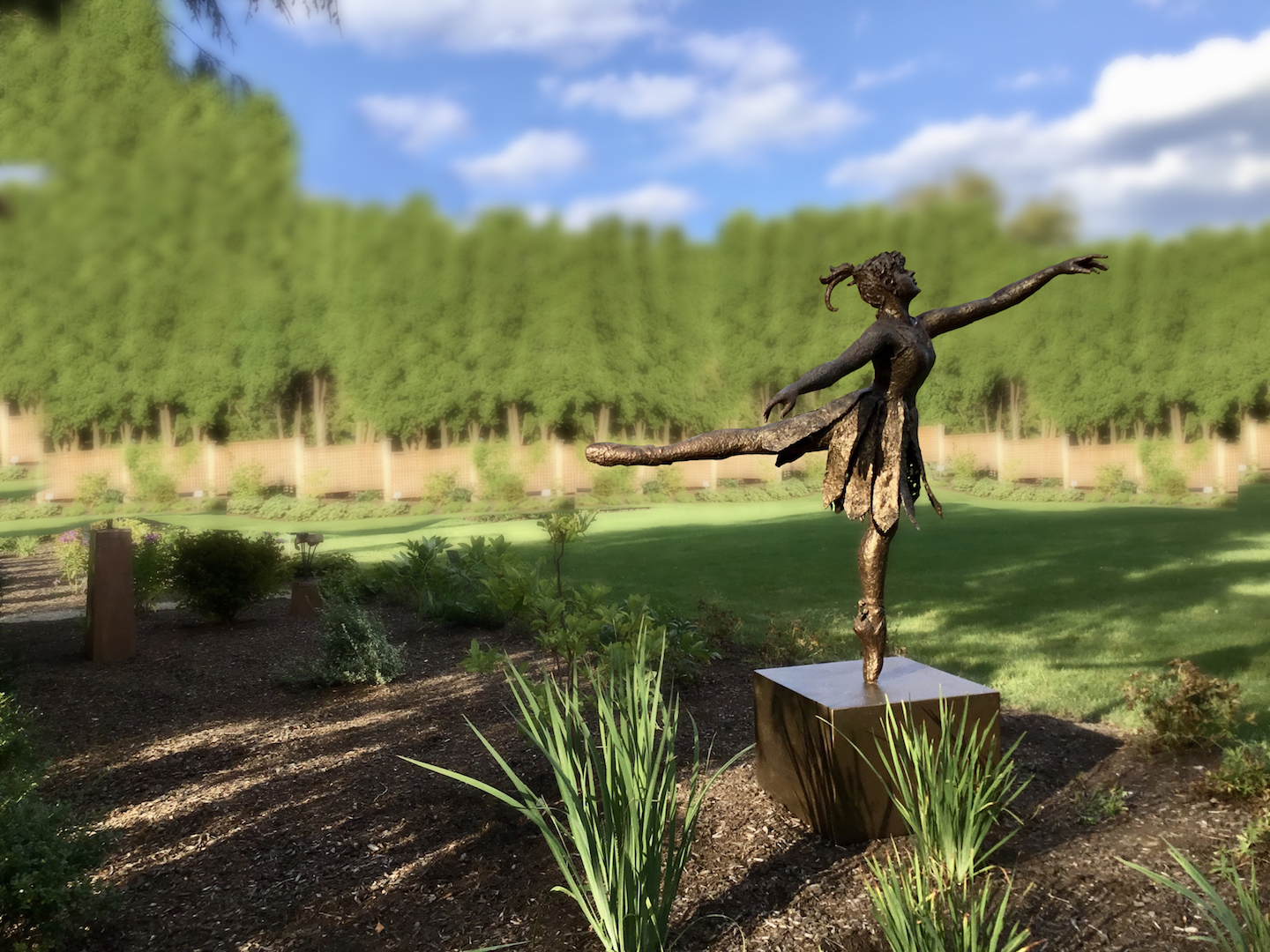
8. Janice Corkin Rudolf - Arabesque
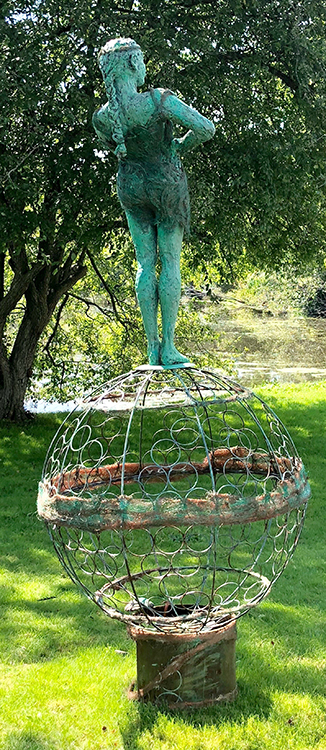
9. Janice Corkin Rudolf - Venus

10. Josie Dellenbaugh - Peaceable Francis
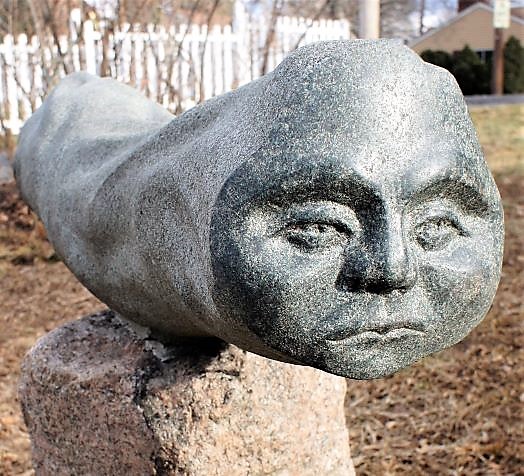
11. Kevin Duffy - Contemplation
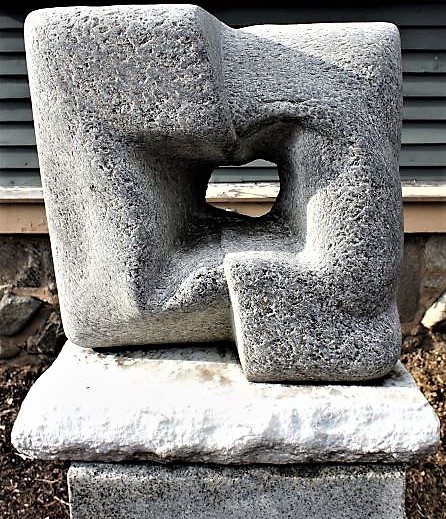
12. Kevin Duffy - Piqued Cube
13. Shawn Farrell - Nigella Damascena/Love In A Mist
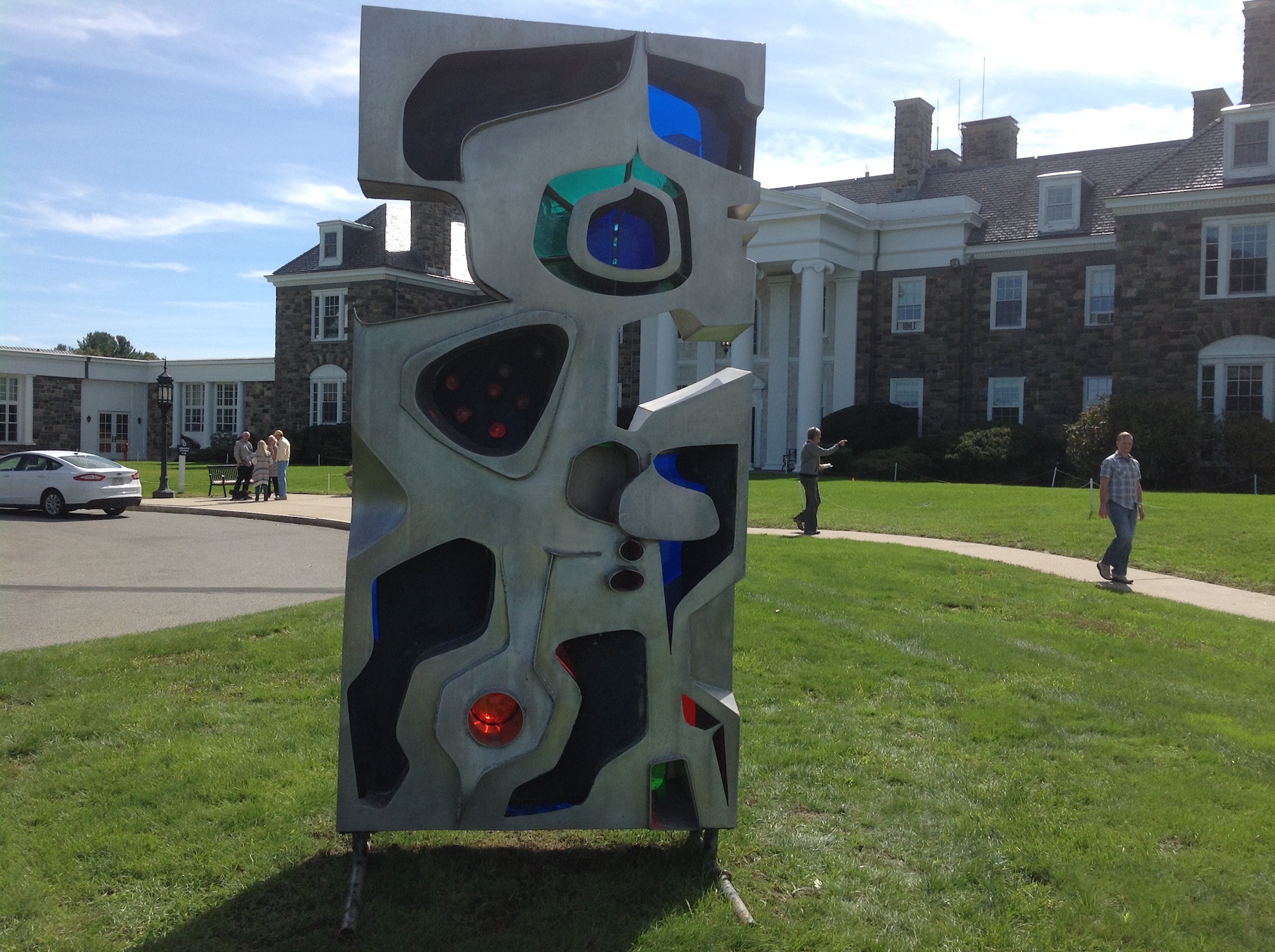
14. Joseph Ferguson - Seven Stars
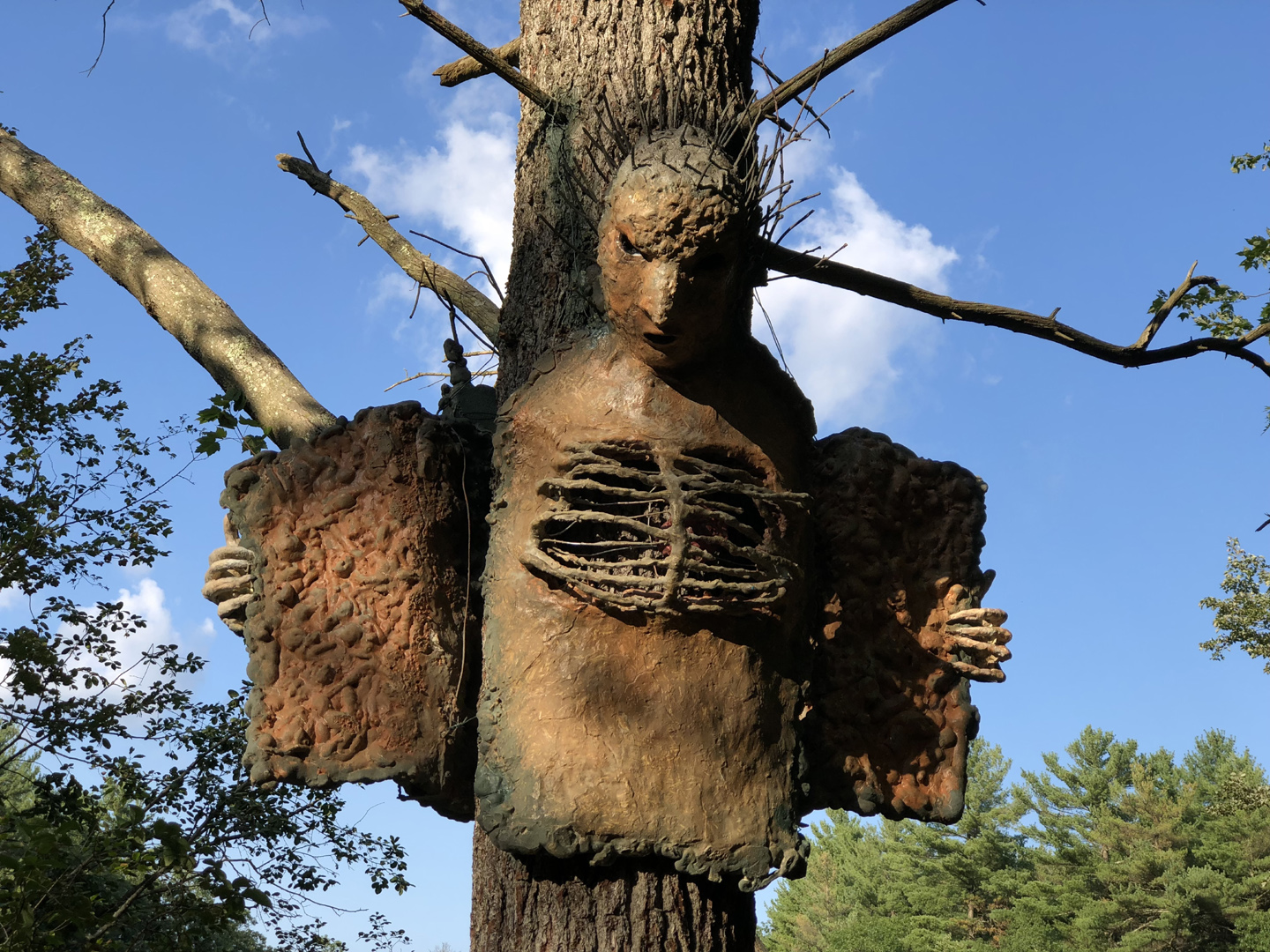
15. Barbara Fletcher - Look Deep into Nature
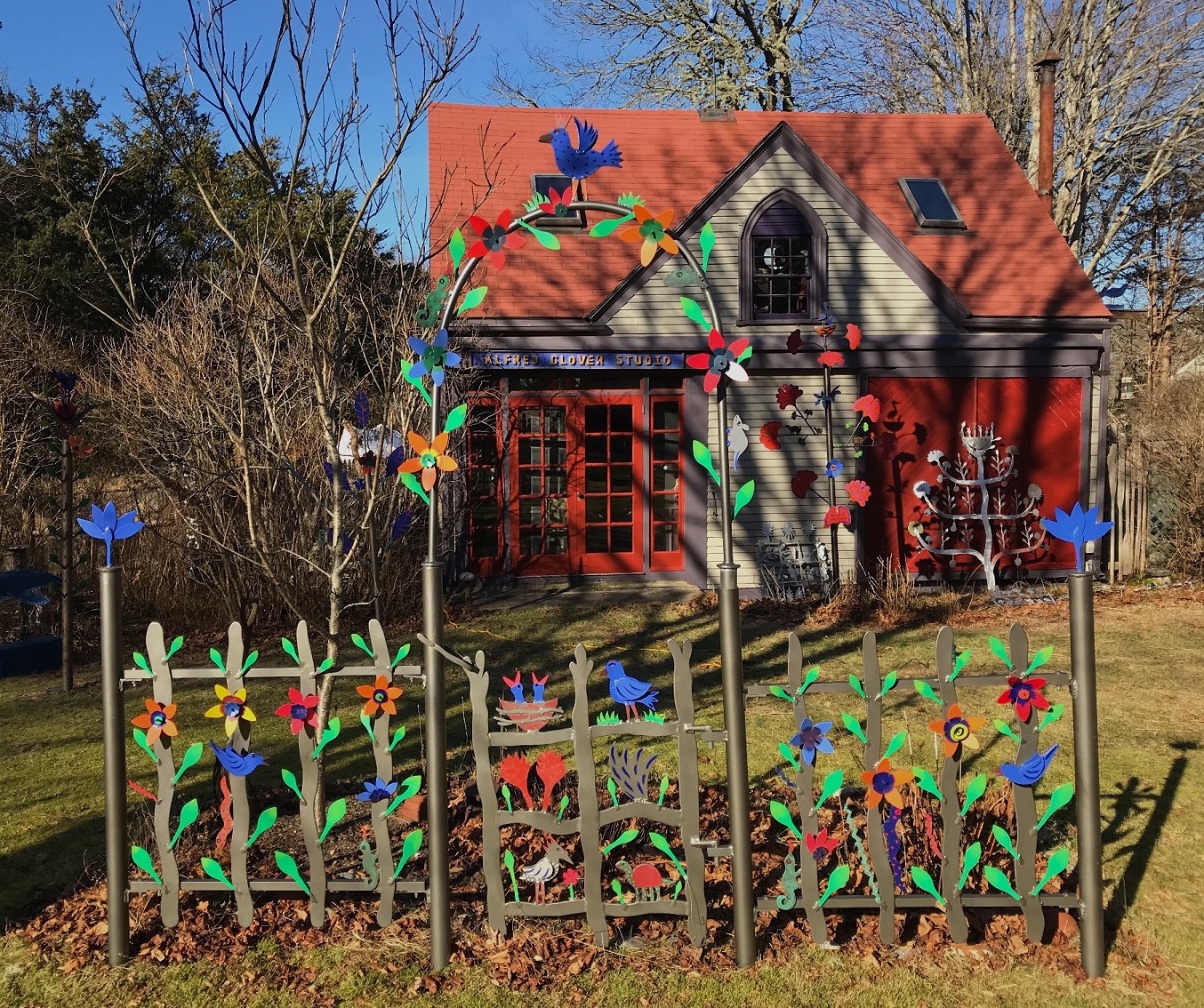
16. Alfred Glover - Garden Gate

17. Alfred Glover - Palms Tree With Heron
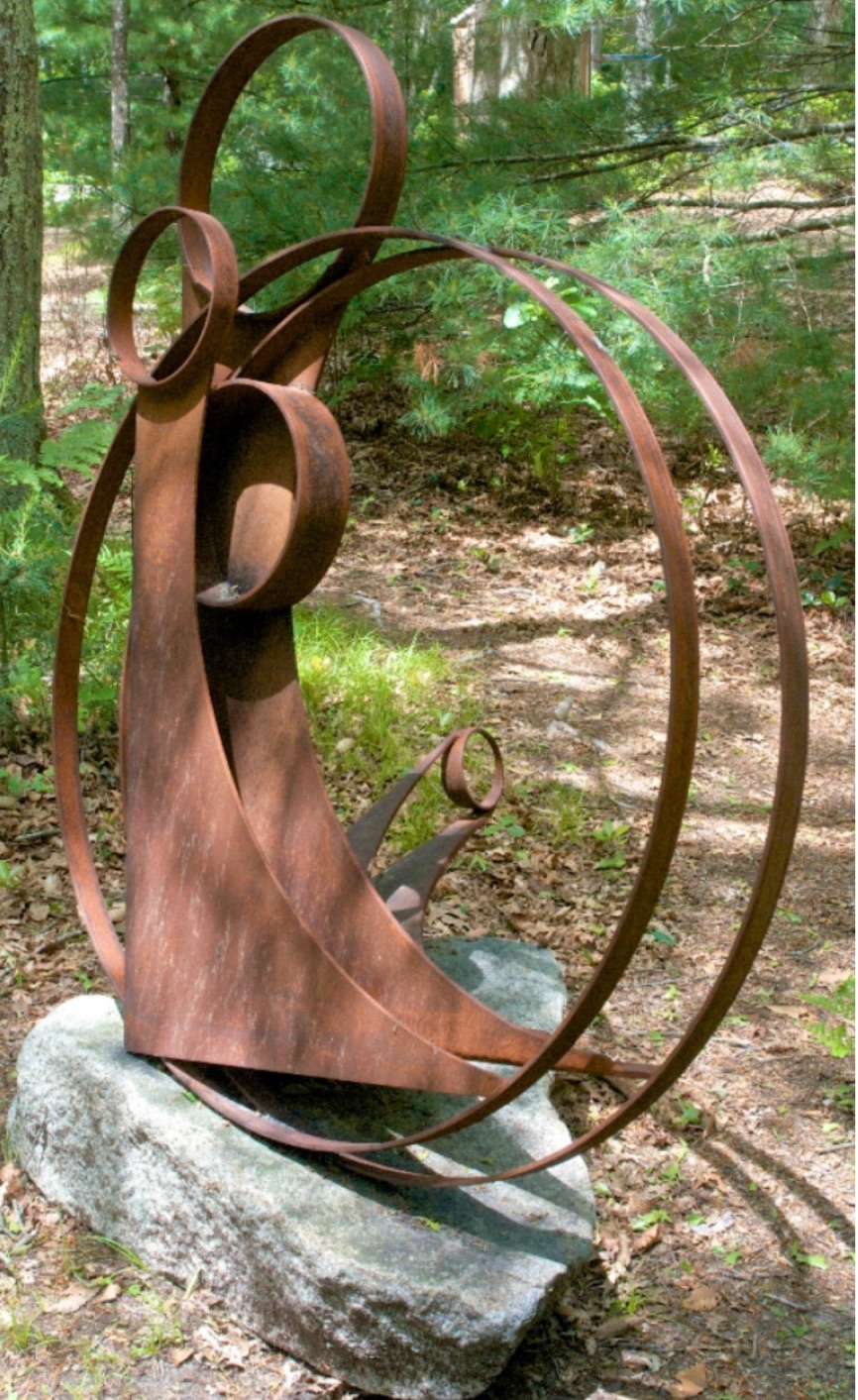
18. Douglass Gray - 79 Degrees
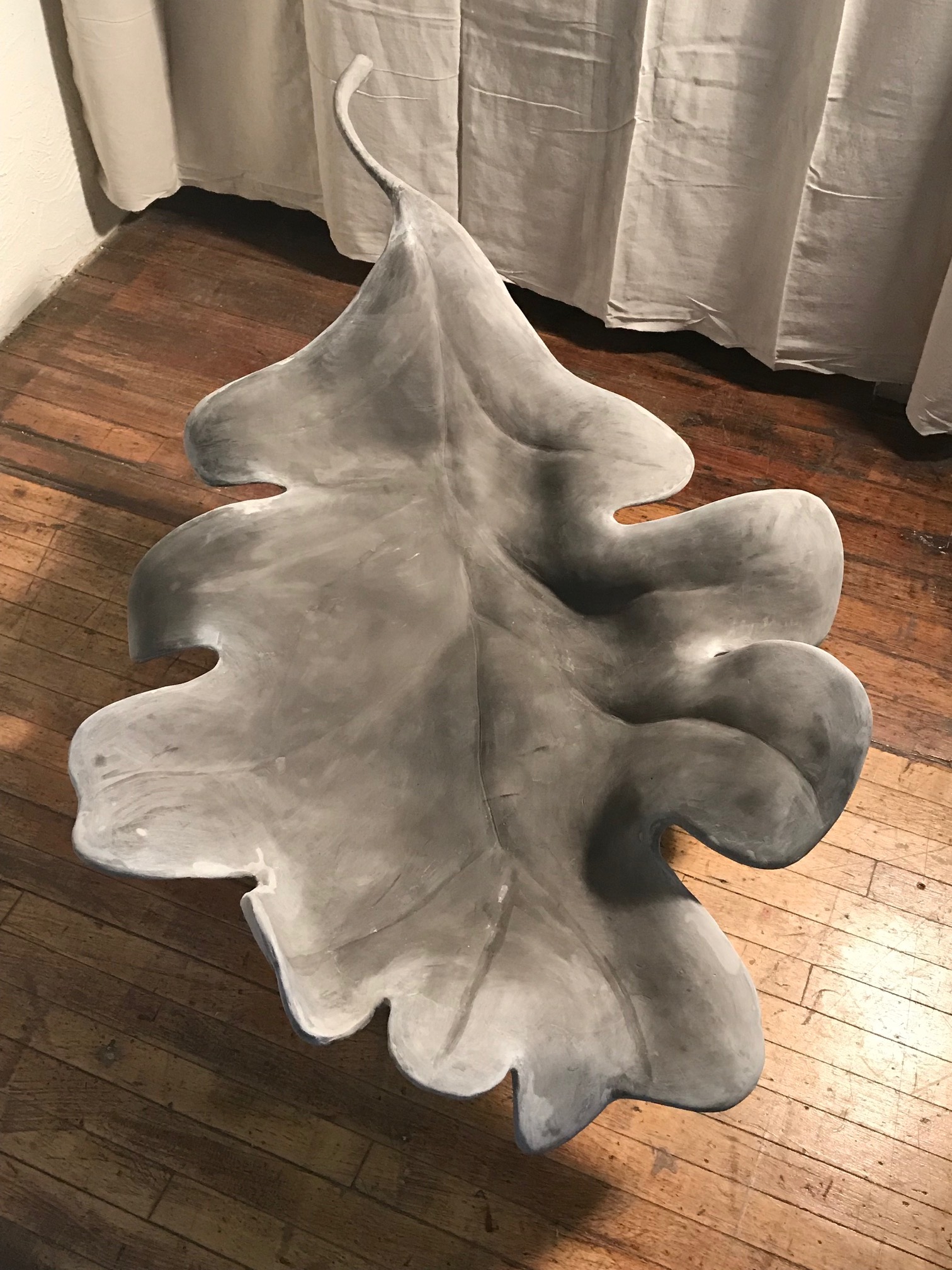
19. Cate Irvine - Oak Leaf

20. Madeleine Lord - Donkey
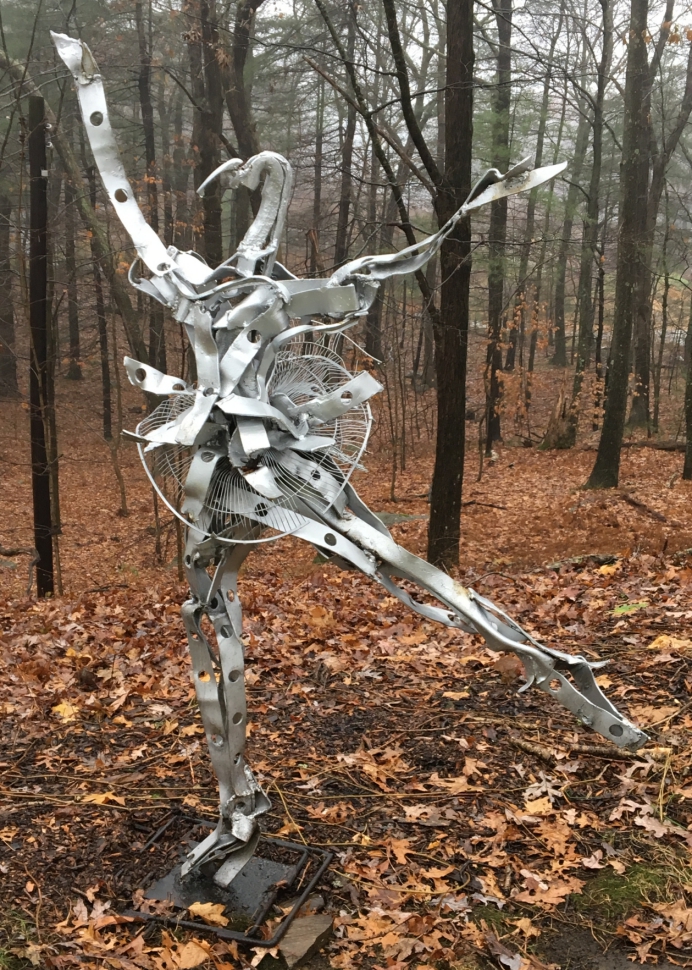
21. Madeleine Lord - Swan Lake
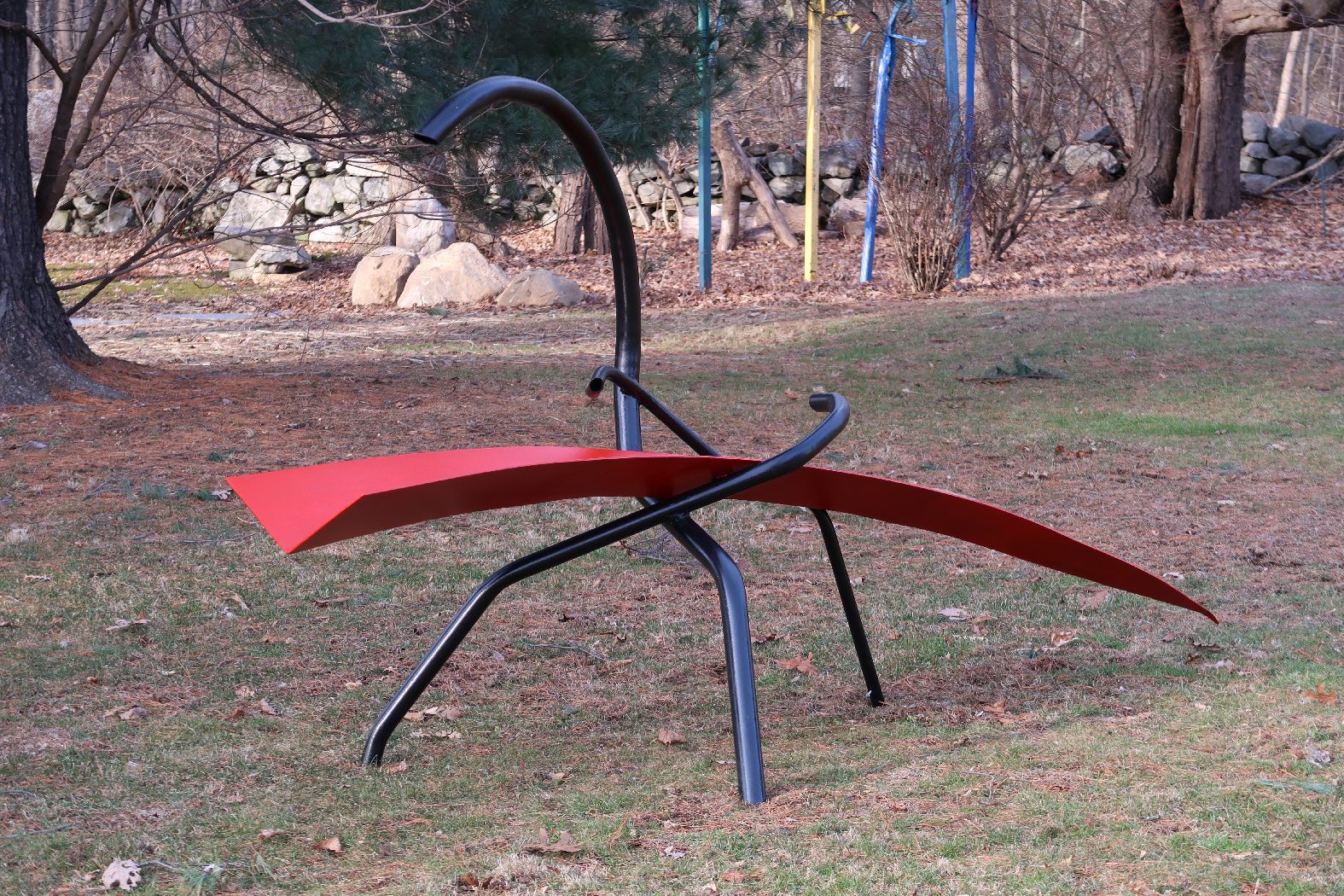
22. Philip Marshall - Care

23. Philip Marshall - Metro
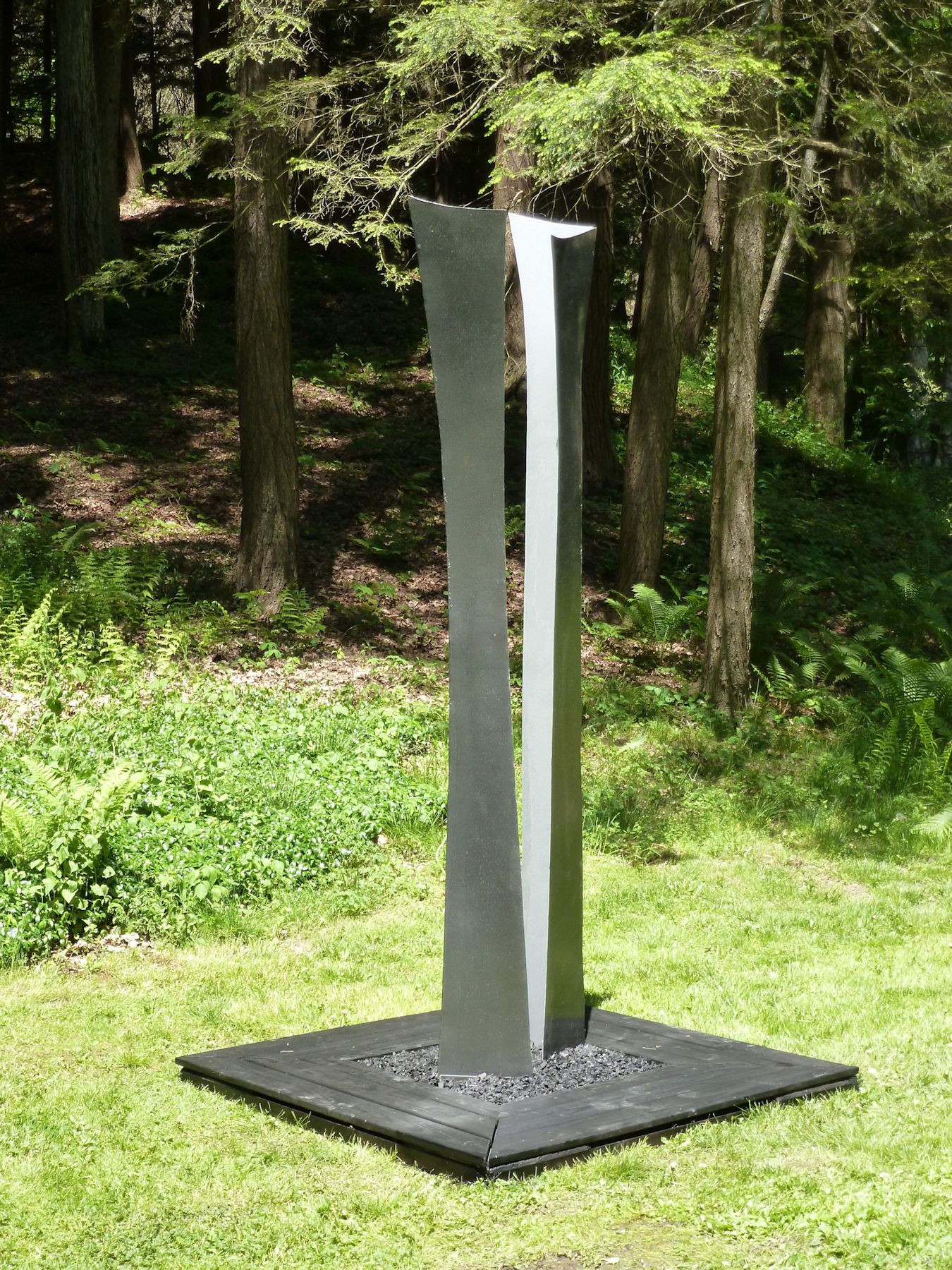
24. Philip Marshall - Next Stop Shibuya
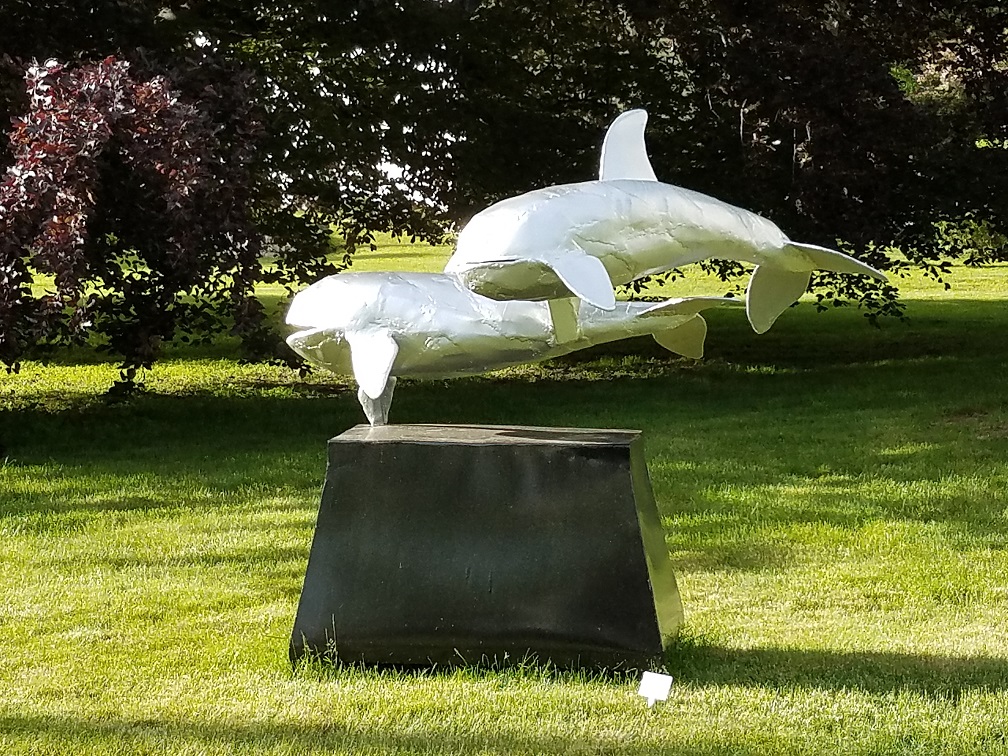
25. Morris Norvin - Flotsam and Jetsam
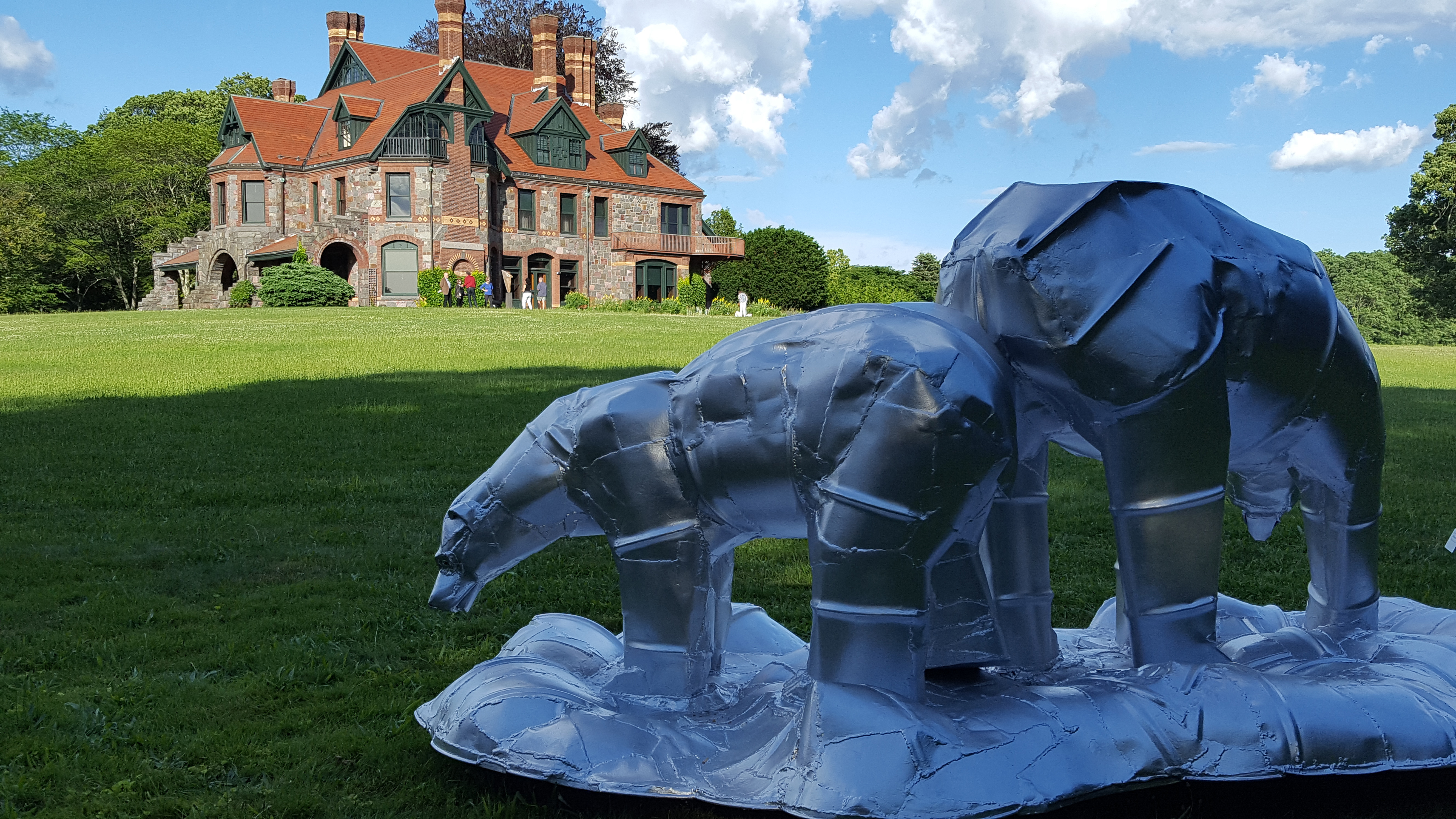
26. Morris Norvin - The Discarded

27. Roe Osborn - SlipSliding II
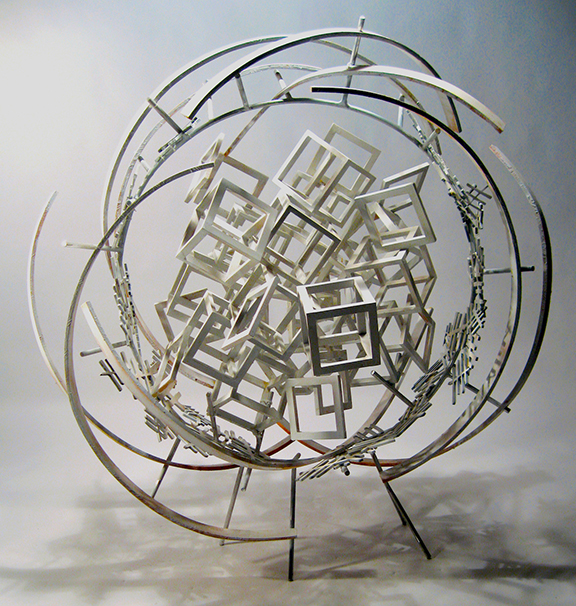
28. Stacy Savage - Turbulence
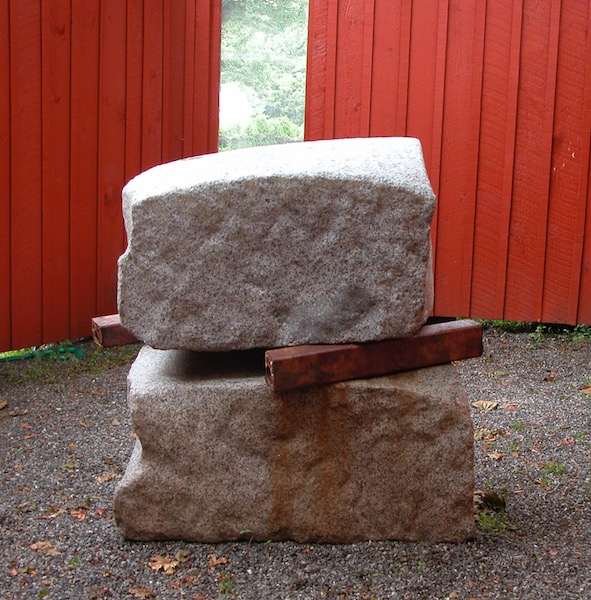
29. Antoinette Schultze - Couplet
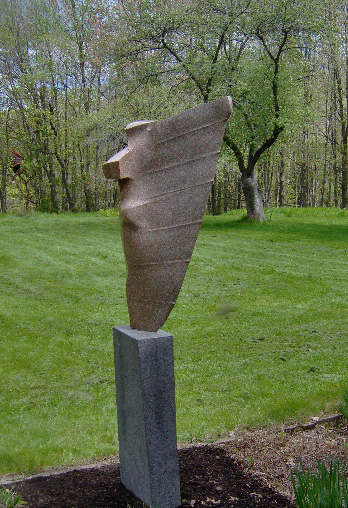
30. Andreas von Huene - Khamsin
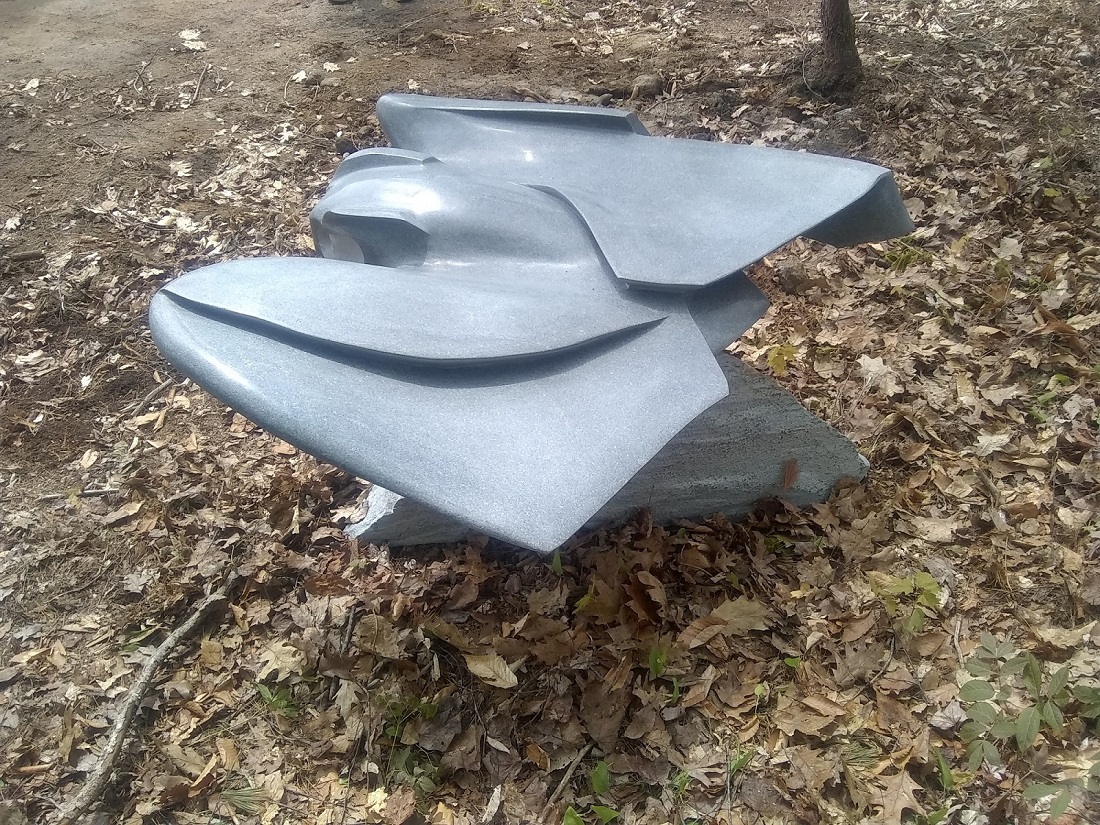
31. Andreas von Huene - Owl Gliding

32. Andreas von Huene - Pull of the Moon
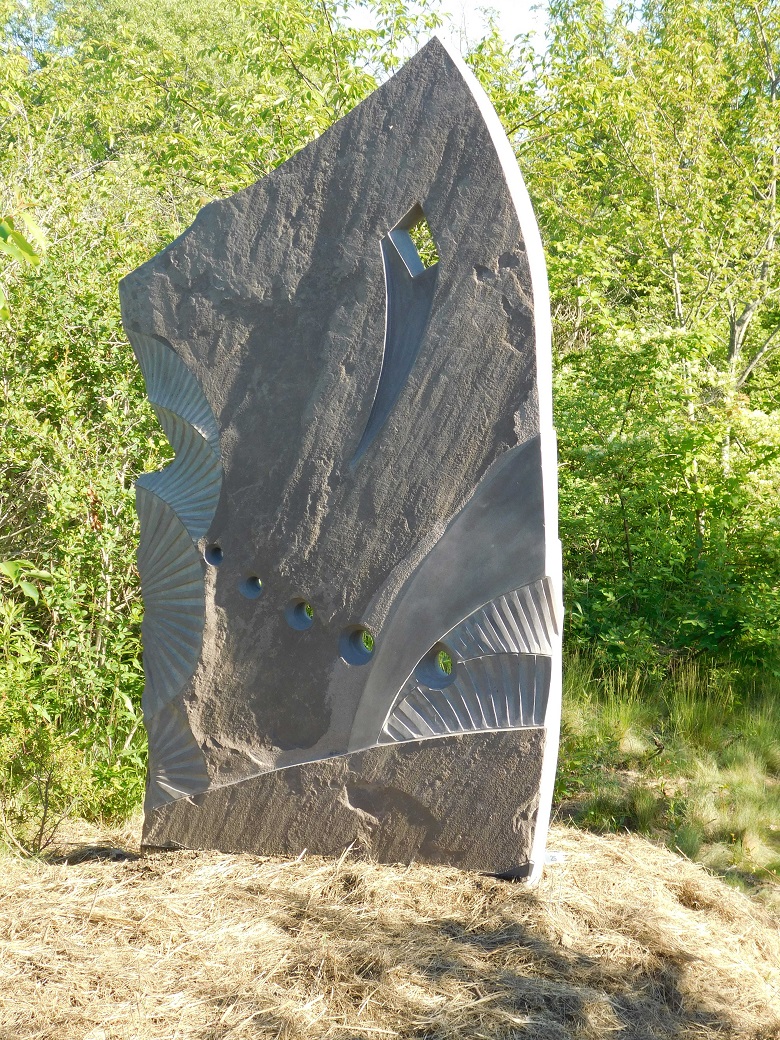
33. Andreas von Huene - Walk the Earth
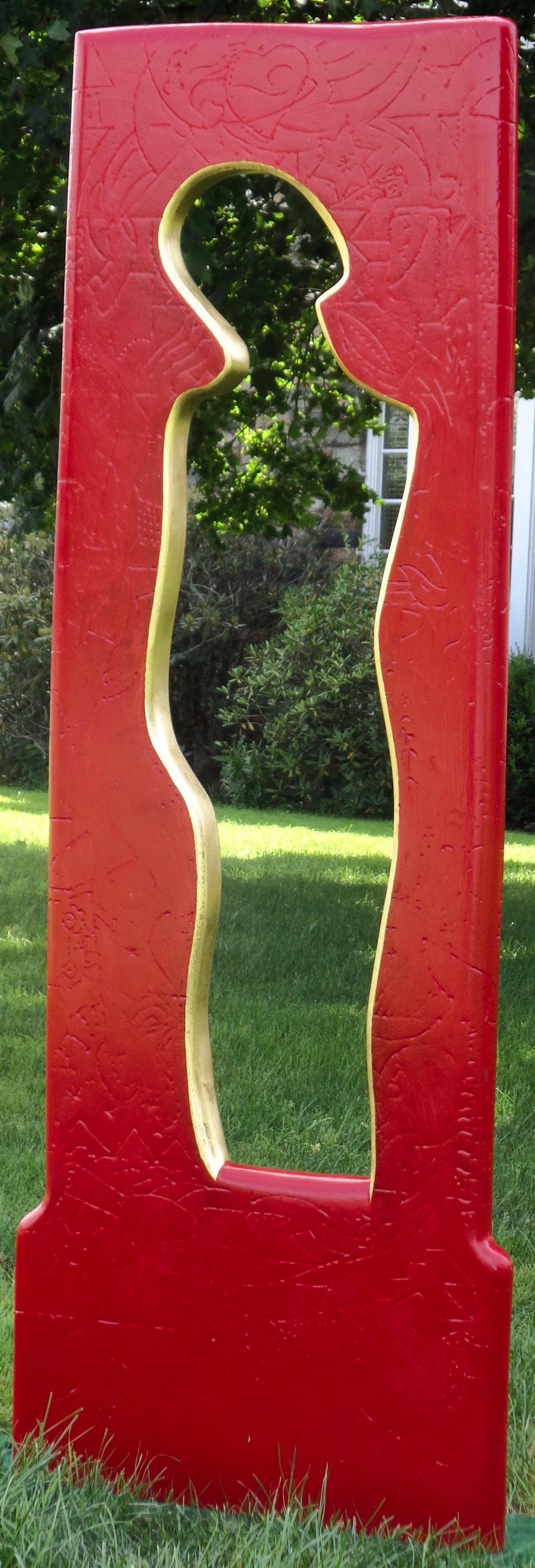
34. Mark Wholey - Red Spirit
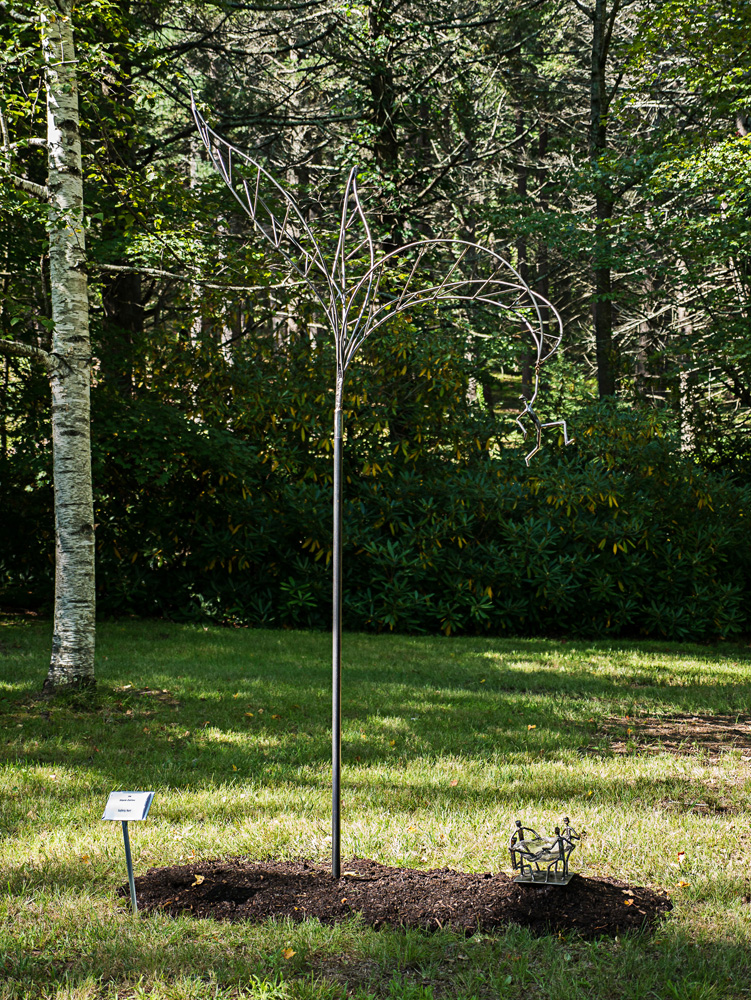
35. Joyce Audy Zarins - Safety Net
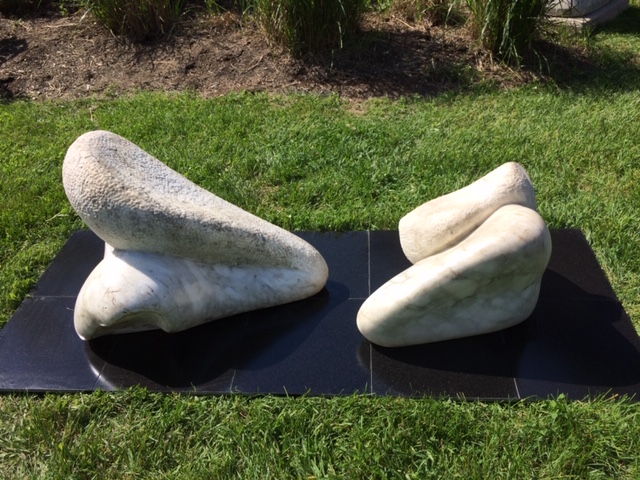
36. Melanie Zibit - Echo
to learn more
Couplet
Antoinette Schultze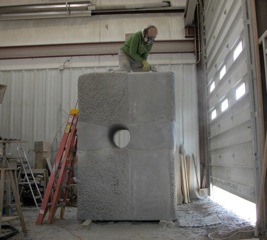
Antoinette Schultze’s Couplet, made of granite, glass, and steel, is shaped to exhibit comfort in a relationship. The two stones are set apart with steel beams, creating space and tension stemming from the balancing of the weight enabling this sandwiched space to exist. Listen to the artist in her own words below.
Backstroker
David AdilmanThis piece started out with a simple curve. That curve became the arched back of a backstroker in the ocean. Click through the images to see the work in progress and listen to the artist talk about the piece below.
Backstroker: Beginning
Philip Marshall
Philip Marshall has five pieces in the exhibition: three outdoors and two indoors. Listen to the artist speak about his works below the next gallery of images.
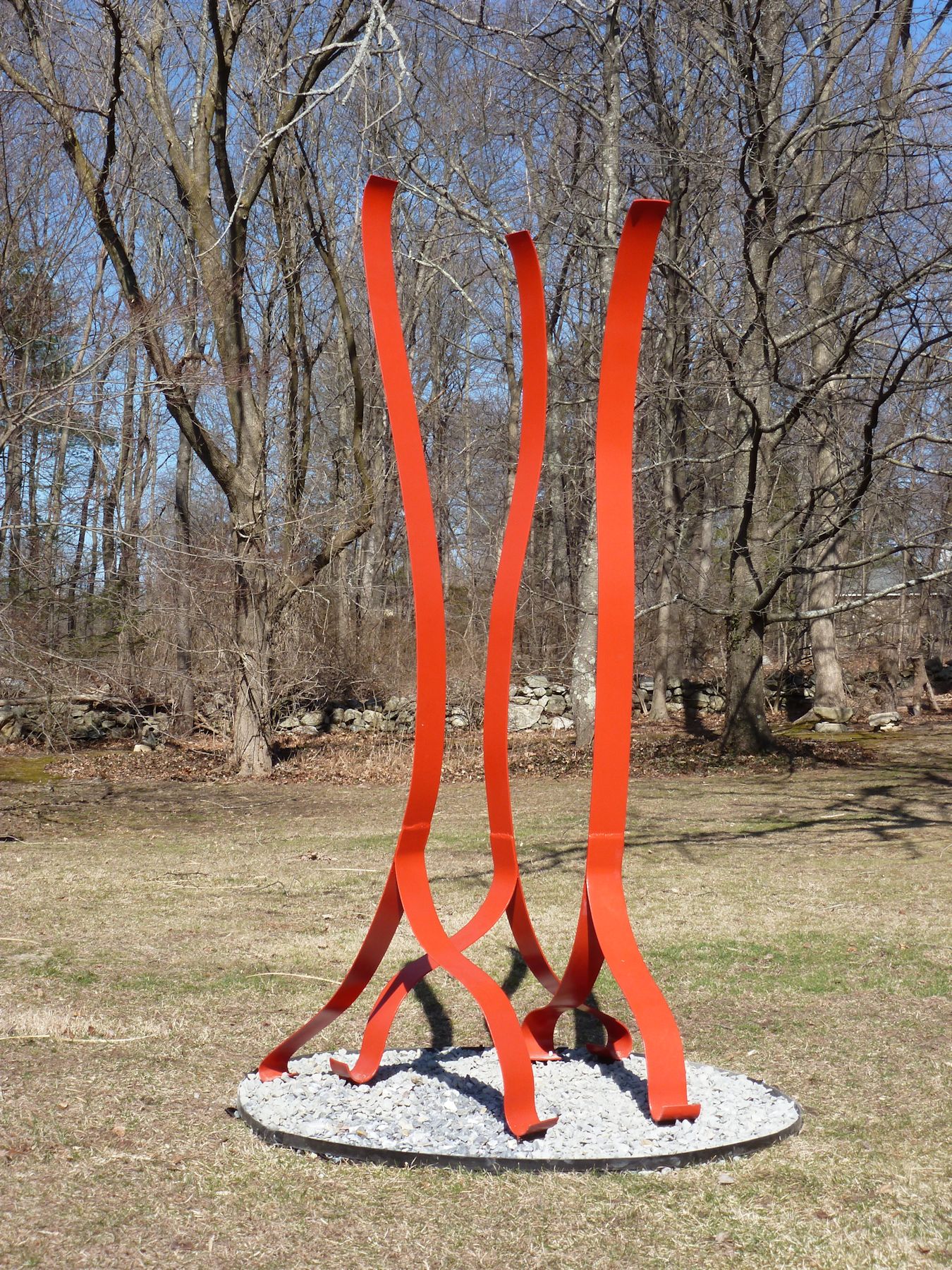
Metro. This installation of “Metro” is part of a larger project in two- and three-dimensional media prompted by my experiences in some of the cities of Europe and the Middle- and Far-East. This project includes my exploration of the loss of individuality of people in the seething mass of humanity of a great metropolis. It is inspired by the rush-hour foot traffic I have encountered in such cities as London, Tokyo and Jakarta. I have the impression that the people, although often appearing visually similar, remain isolated individuals as they purposefully make their separate, but intersecting, ways to work.
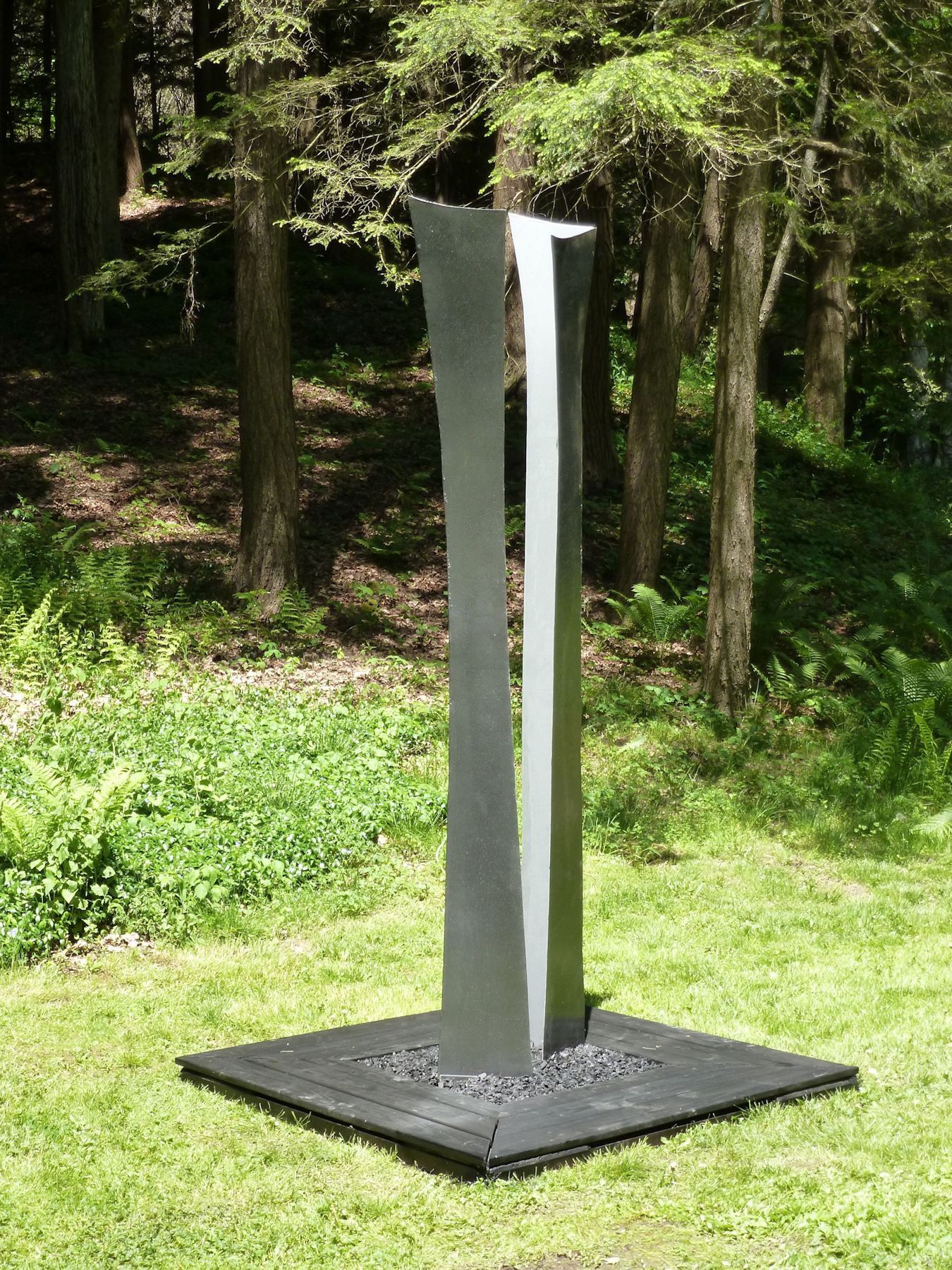
Next Stop Shibuya 次渋谷 . Although executed as an abstract sculpture, now completed, it reminds me of my rush hour experiences on the Tokyo Metro and commuter trains. Being crushed together, often face-to-face with total strangers, too squeezed together to even breath properly, requires a mental preservation of personal space that is not possible physically. The outward curve of these two elements suggests to me the mental separation despite physical proximity that Tokyo, like almost all large cities, requires if one is to maintain one’s own individuality. Having been compressed into a railway car at Shinjuku, and being pushed further in at each stop, hearing “The next stop is Shibuya”, my destination, was a welcome announcement.
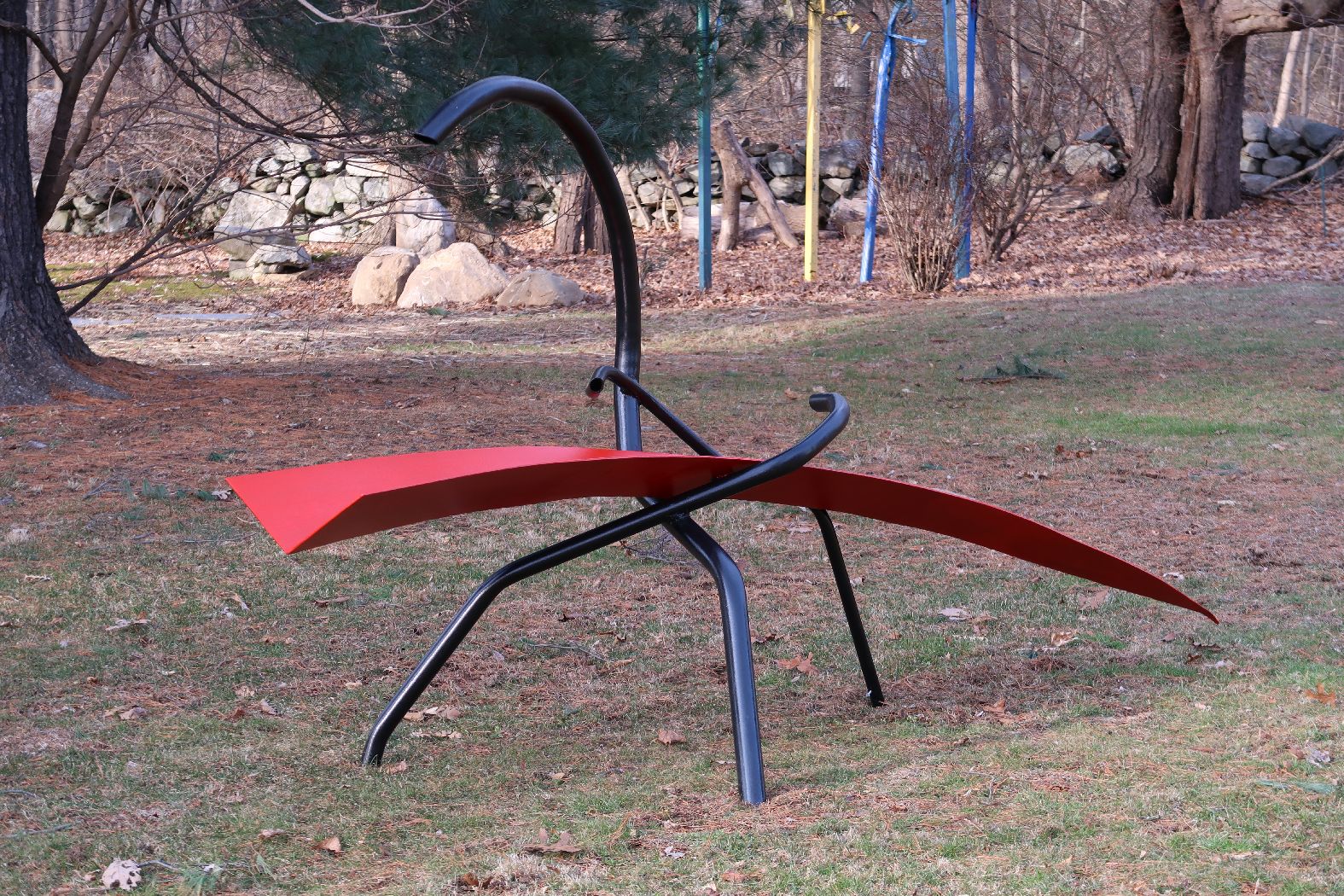
Care. I wanted to explore further the shape produced by joining two steel strips along a curved edge that I used in “Next Stop Shibuya”. This simple act of joining two simple shaped sheets can produce a three-dimensional object that reminds me of my times in Japan. I also wanted to challenge myself to create a horizontal piece, and to explore contrasting planes with tubes. The resulting arched shape of the sheets suggested to me a recumbent person, the tubing a caring other; I was reminded of the emotions provoked by “Pieta”. I have had difficulty settling on a title for this abstract piece that would not prejudice the viewer as the contrasting shapes may suggest conflict or tension to some, whereas the composition may suggest the opposite to others. Originally I painted the piece all black; I have repainted the arched element to create more presence and to emphasize that there are two elements that hint at two figures: one draped over the other.
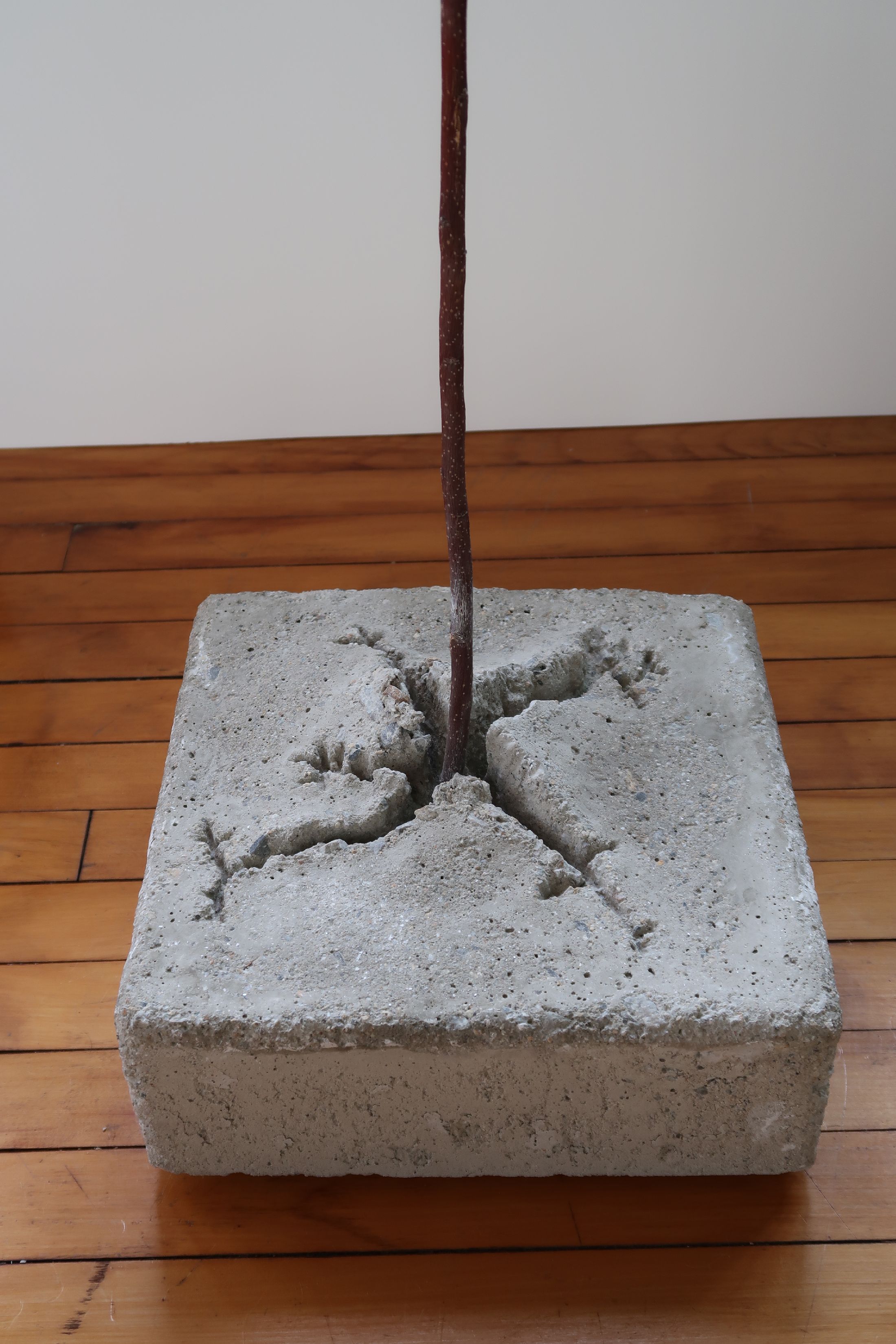
Natural Selection. Since the mid–20th century, concrete has replaced stone as the artist’s metaphor for enduring strength, and for the human taming and domination of nature. I am exploring the themes of “civilization’s” arrogance and self-justifying social order. Our ability to displace nature and destabilize the world’s ecology is very disturbing. However, I am heartened by nature’s resilience and persistence in re-taking the ground that it loses. One has only to see nature’s overwhelming of artifacts of past civilizations, the re-growth of New England’s forest, the grass on a rural road, or the pure riot of a tropical forest to realize that, despite our seemingly all-powerful efforts to impose everlasting marks on the environment, we are only temporary masters of our world. A frail sapling bursting through concrete to remind us of the temporal limits of our power is perhaps a spark of hope.
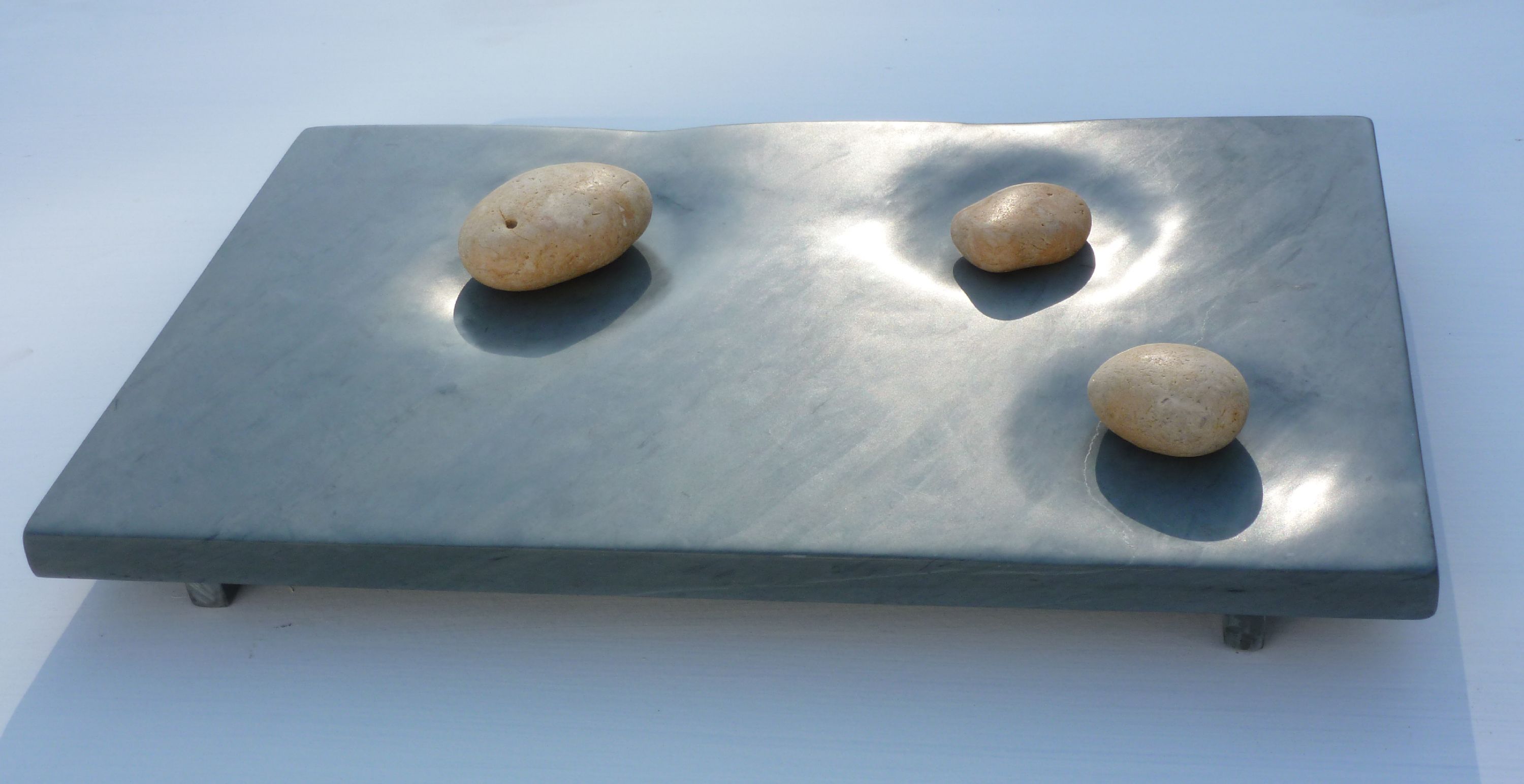
Resting Places. I created this piece for an art show for the visually–impaired, so I made it as a tactile piece to be touched. I wanted to contrast the silky-smoothness of the slate that I polished, with the rough texture of the stones that were naturally smoothed by being churned together for millennia by the grey English Channel. I had in mind the hollows that stones sometimes have made in rocks by their endless action in fast-moving water, or when used by ancient peoples over many generations for the repeated grinding of corn at the same location. I thought such stones looked as if they had nestled down to rest.
Look Deep Into Nature
Barbara Fletcher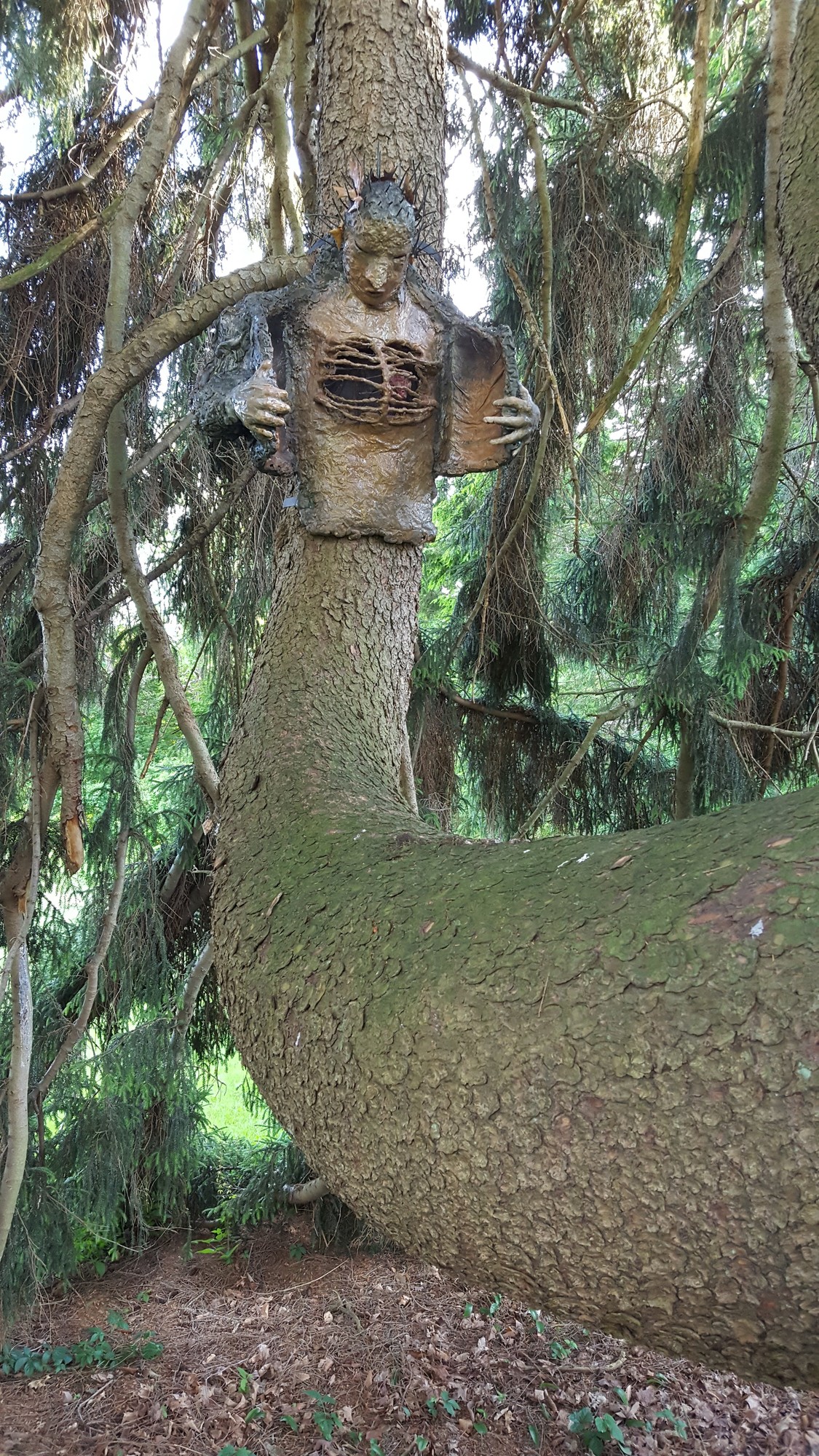
“I am a storyteller and an observer of nature and the nature of the human condition. Color, humor and animation are important aspects of my work. Growing up on a farm as a child I played and fantasized in the large barns in the back of my house. Working with my hands I assembled special environments for myself and these became my living sculptures.
As an adult I became a sculptor of paper and mixed media, creating environments on a larger scale. In recent years I have been very interested in environmental issues and much of my art reflects these themes sometimes in a fantastical way.
The title of this piece Look Deep into Nature is taken from a quote by Albert Einstein, “Look deep into nature and you will understand everything better.”
I believe that the power of human encounter with nature can be a religious experience. I believe nature is divine. Sadly it seems as if nothing is sacred today and trees and nature are threatened by climate change.”
Red Spirit
Mark Wholey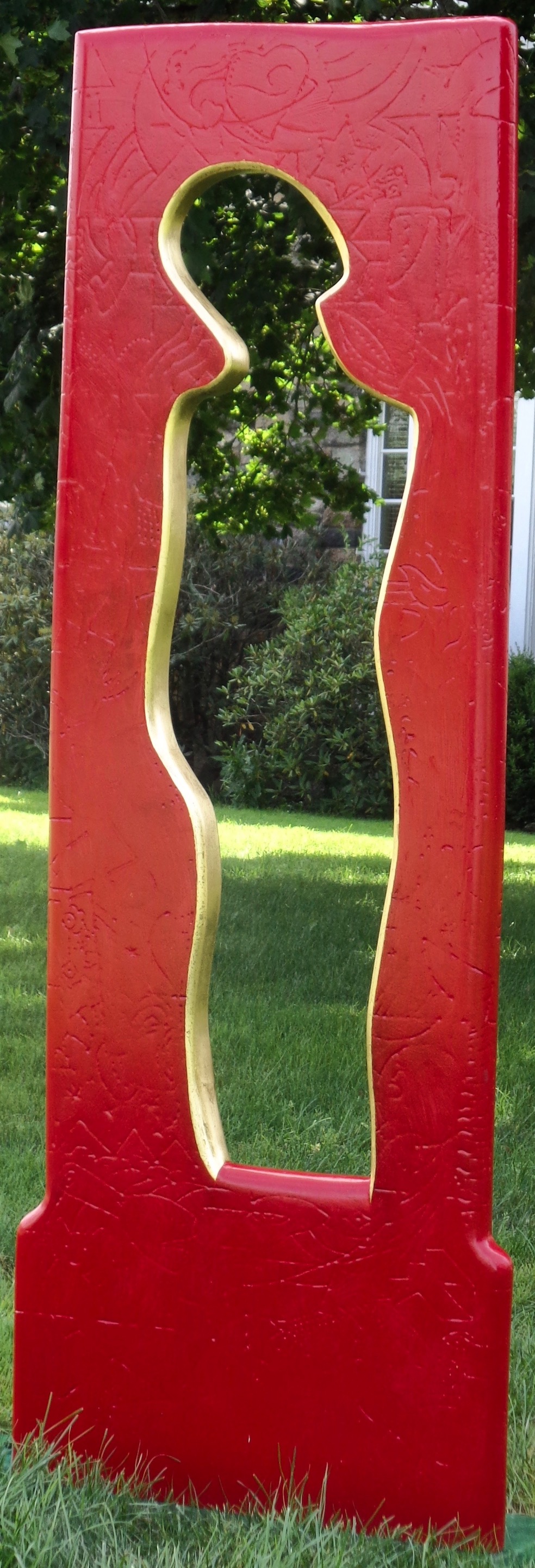
Red Spirit is a sculpture of a figure that is there and not there. It is inspired by observing a friend, an opera singer, standing before an audience, poised, collecting her thoughts. A poignant moment between emptiness and fullness. Nothing and something. The absent figure in the sculpture is the intangible. Inscribed around the missing figure are designs and symbols of tangible, everyday life, raising the question of who we are? What makes us who we are? I wanted the work to simultaneously express contemplation and inspiration. To let the observer fill the void and identify the figure. The sculpture is made of painted high density urethane and inscribed with 24K gold leaf to energize the form.
The poem below by Mark Strand speaks to this sculpture.
Keeping Things Whole
In a field
I am the absence
of field.
This is
always the case.
Wherever I am
I am what is missing.
When I walk
I part the air
and always
the air moves in
to fill the spaces
where my body’s been.
We all have reasons
for moving.
I move
to keep things whole.
Turbulence
Stacy Latt Savage
“My starting point for this sculpture was feeling; a sense that our culture feels askew, disjointed and at times out of control. It is difficult for us to assess today what is real, what to trust, and I believe there is an ever present undertone of “what’s next?”. When creating this sculpture, I began with regular shapes, rings,that could have made a visually organized sphere but instead I sent them off-kilter spiraling with no sense of order except to generate visual perpetual motion, a chaotic ripple effect. At the core of the sculpture is a sacrum. The sacrum is the bone at the end of our spine, our tailbone, and is derived from 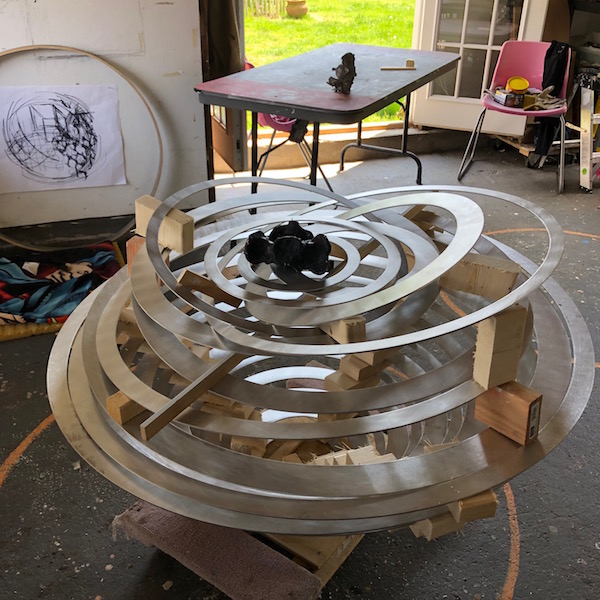 a Latin word meaning sacred. In this sculpture, the sacrum is us, humans, and our potential. A tail emerges from the sacrum in this sculpture that is prickly and barbed and has set the chaos in motion. I believe humans have the power to do ultimate good for ourselves, for our planet and for all living things. Yet our global cultural course does not appear to be moving uniformly in this direction. In my studio, I observe, build, cut away, add, break down, build up, edit, layer and invent – all the while wrestling to compose what it looks like to feel human. I choreograph shapes and forms moving through space to create dynamic visual experiences that reflect what I perceive as cultural anxiety. Physical systems, patterns and shapes from nature, properties of cause and effect and the human condition are all fuel for my work. I search for idiosyncratic combinations, my own gestural language and personal metaphor to create sculpture that embodies the underlying turbulence that I feel signifies our times.”
a Latin word meaning sacred. In this sculpture, the sacrum is us, humans, and our potential. A tail emerges from the sacrum in this sculpture that is prickly and barbed and has set the chaos in motion. I believe humans have the power to do ultimate good for ourselves, for our planet and for all living things. Yet our global cultural course does not appear to be moving uniformly in this direction. In my studio, I observe, build, cut away, add, break down, build up, edit, layer and invent – all the while wrestling to compose what it looks like to feel human. I choreograph shapes and forms moving through space to create dynamic visual experiences that reflect what I perceive as cultural anxiety. Physical systems, patterns and shapes from nature, properties of cause and effect and the human condition are all fuel for my work. I search for idiosyncratic combinations, my own gestural language and personal metaphor to create sculpture that embodies the underlying turbulence that I feel signifies our times.”
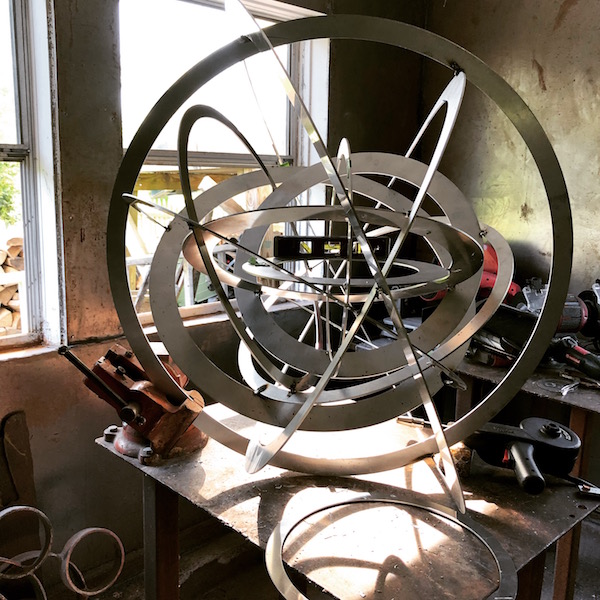
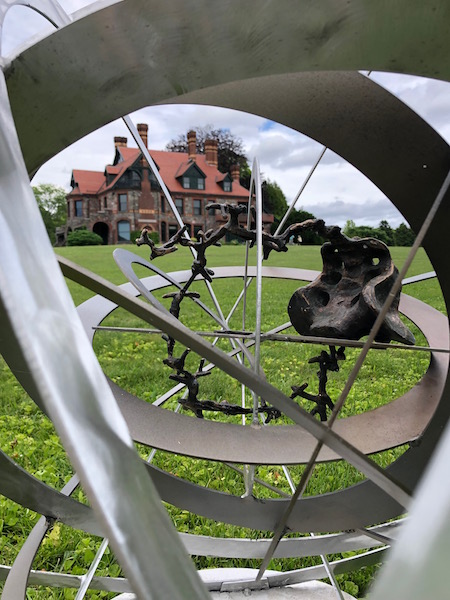
Echo
Melanie Zibit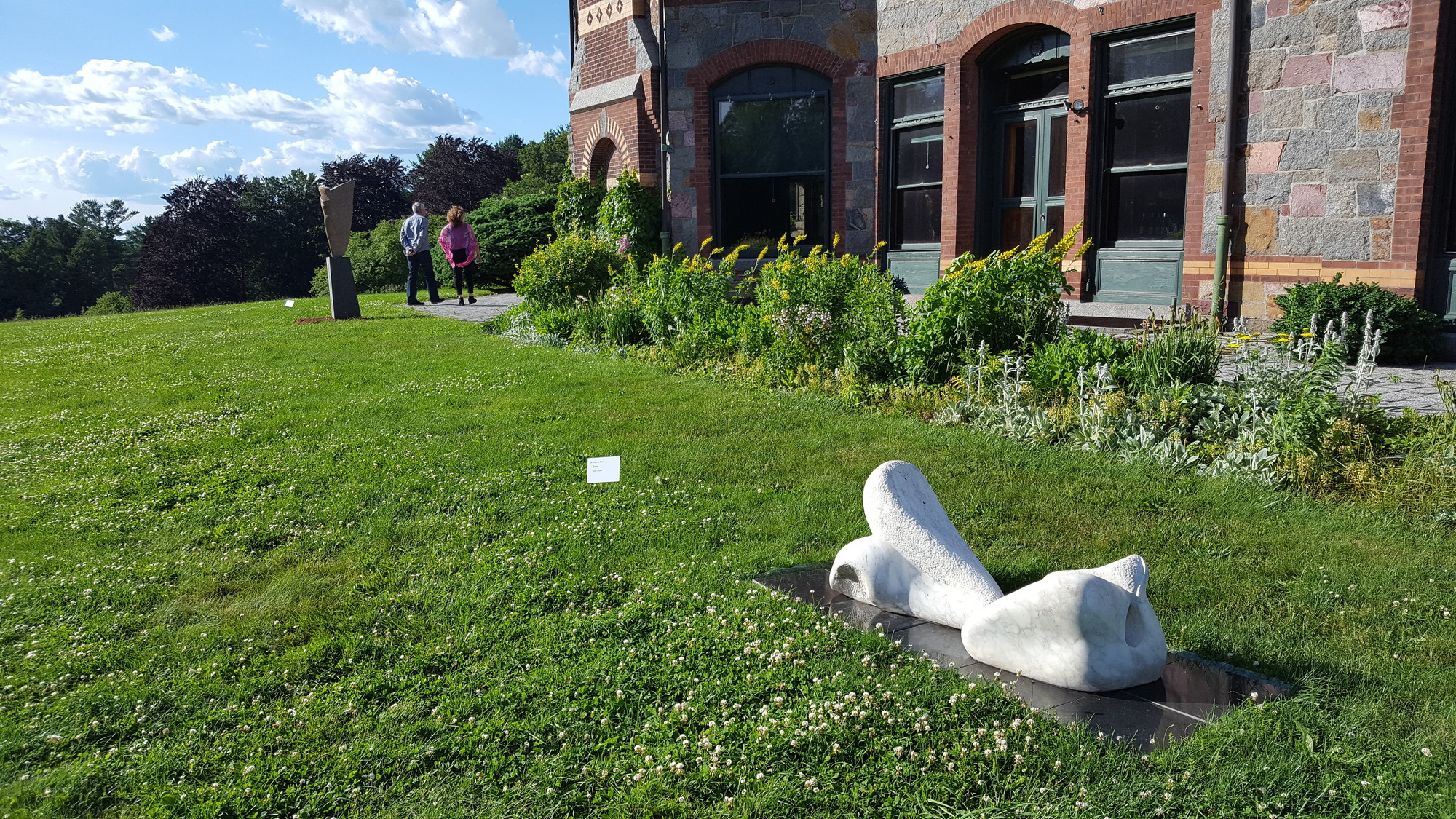
“The two forms of my sculpture, Echo, reflect back and forth to each other through shape and movement, with the smaller form amplified by the larger, making a visual metaphor of an echo. Creating a two part sculpture requires working on both pieces at the same time so that they visually relate.
Echo, in Greek mythology, was a mountain nymph who offended the goddess Hera by keeping her in conversation thus preventing Hera from spying on her husband, Zeus, with a lover. To punish Echo, Hera deprived her of speech, except for the ability to repeat the last words of another. Thus is an “echo.”
I carved Echo in one of the historic marble workshops in Carrara Italy, the same workshops where Michelangelo and his workmen carved during the Renaissance. The workshop walls were lined with shelves filled with sculptures from generations ago as well as those of modern sculptors, enhancing the environment and giving me the sense I was working around the ghosts of sculptors through the ages.”
Madeleine Lord
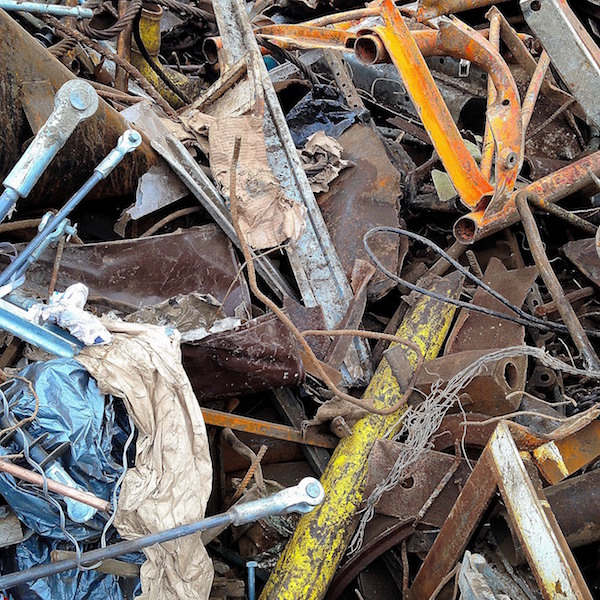
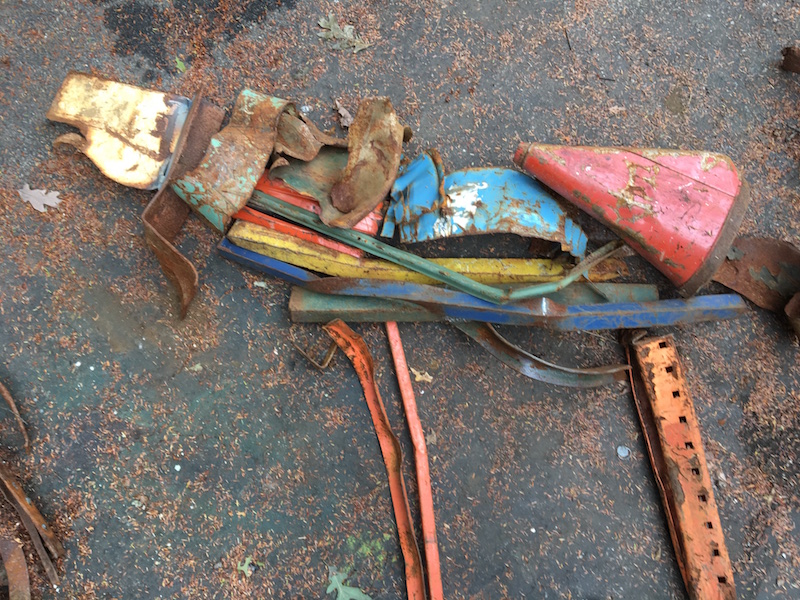
“My welded art starts at the metal yard where I find the pieces that eventually become heads, arms, legs, flowers, angels, animals, and folks. I start with carefully selected scrap metal. My process is not unlike assembling a 3-D crazy quilt, where each scrap is interesting in its own right, but is redefined by inclusion to become something else entirely. My hope is to create a multi-dimensional drawing where the pockets of air are as interesting as the pieces of metal that create them. The whole drawing is an assemblage of many smaller ones.
DONKEY started like this–a set of colored metal pieces laid out on the driveway. The white piece that looked like a Donkey’s head to me started it. It took three years to find all the parts on the piece you are looking at in the Eustis show.
The piece called Swan Lake started with a fan cover that looked like a ballerina tutu and a chrome handle from an old refrigerator that looked like a swan’s beak. I worked on it for several years, displaying it at the Pingree School Flying Horse Sculpture show 2017 and in the 2018 Newton Highlands Studios Without Walls Beyond Boundaries show. Each year it grew and changed, as I found more parts that would fit.
If you look closely you can see the changes to the base, legs, arms, and costume.”
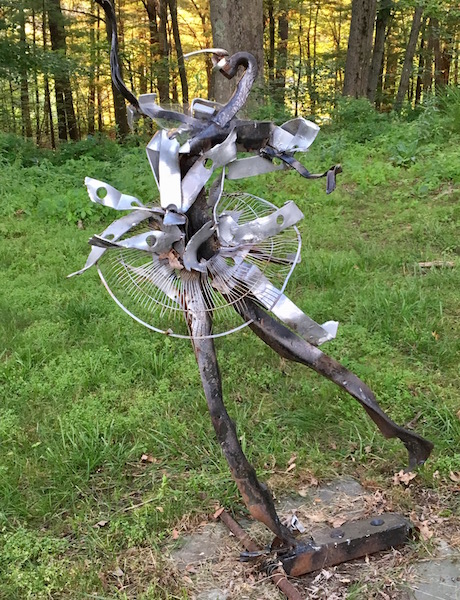

Guandul
Anne AlexanderAnne Alexander gives us a peek behind the scenes at her process carving Guandul from granite.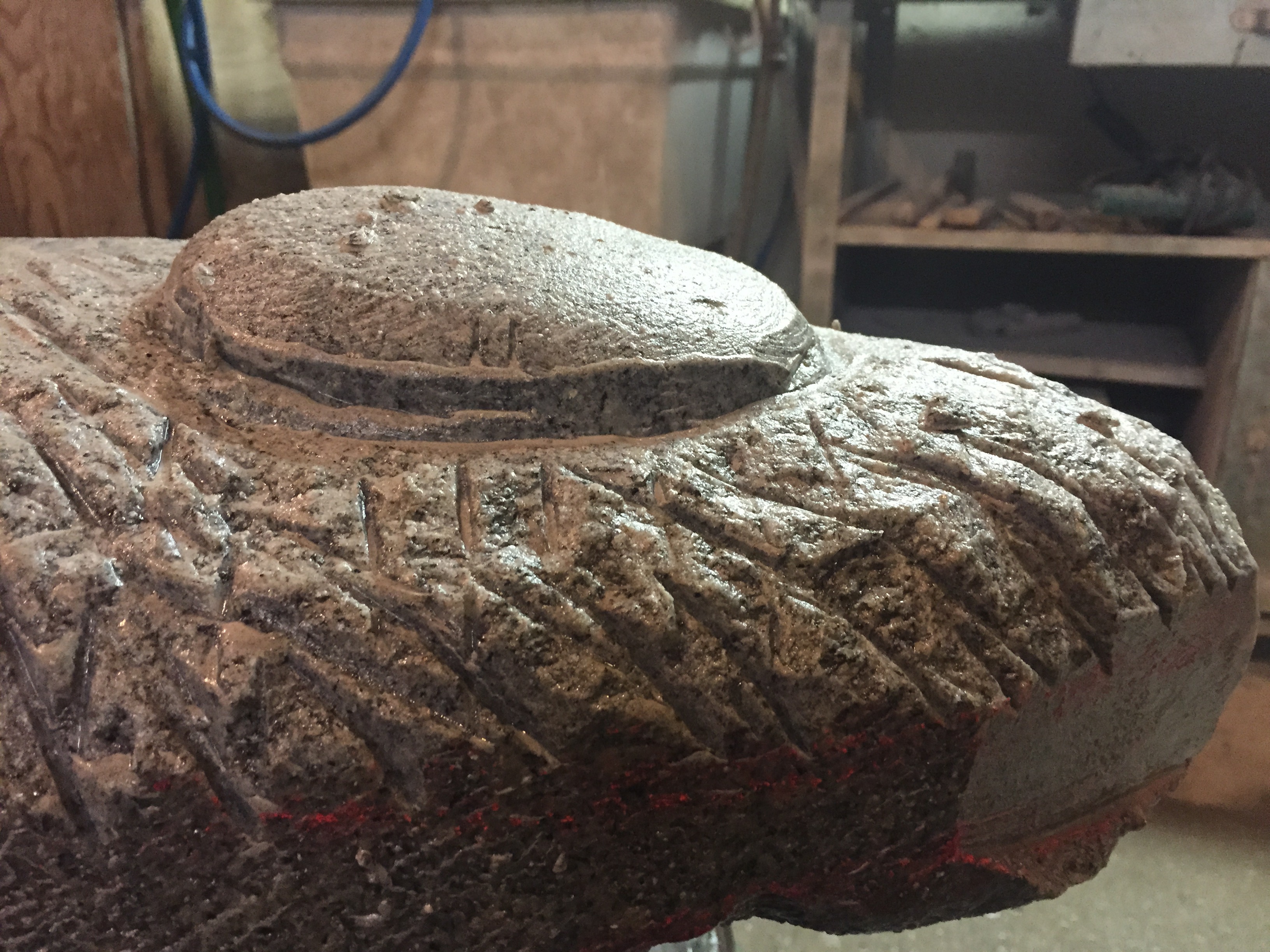
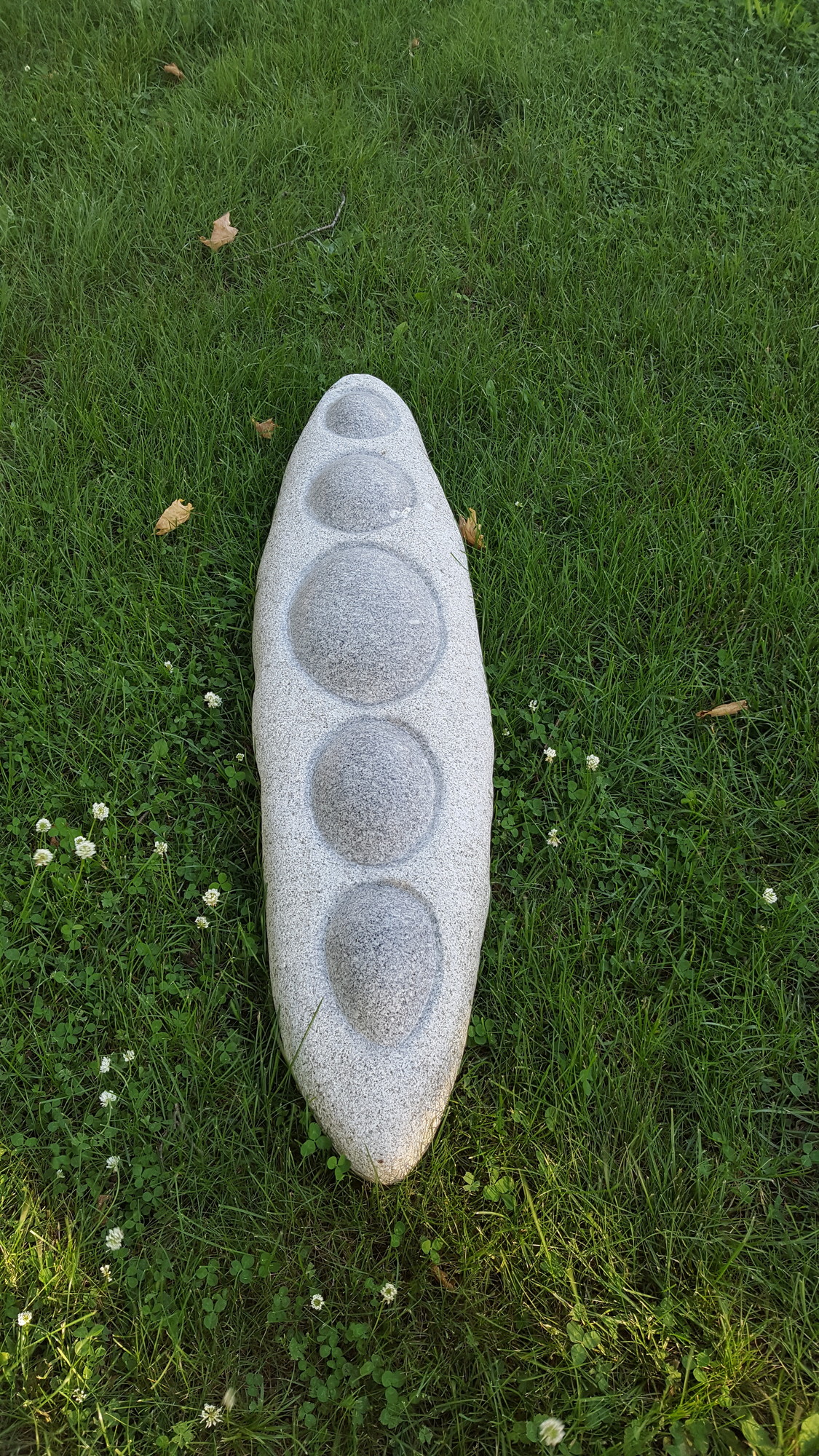
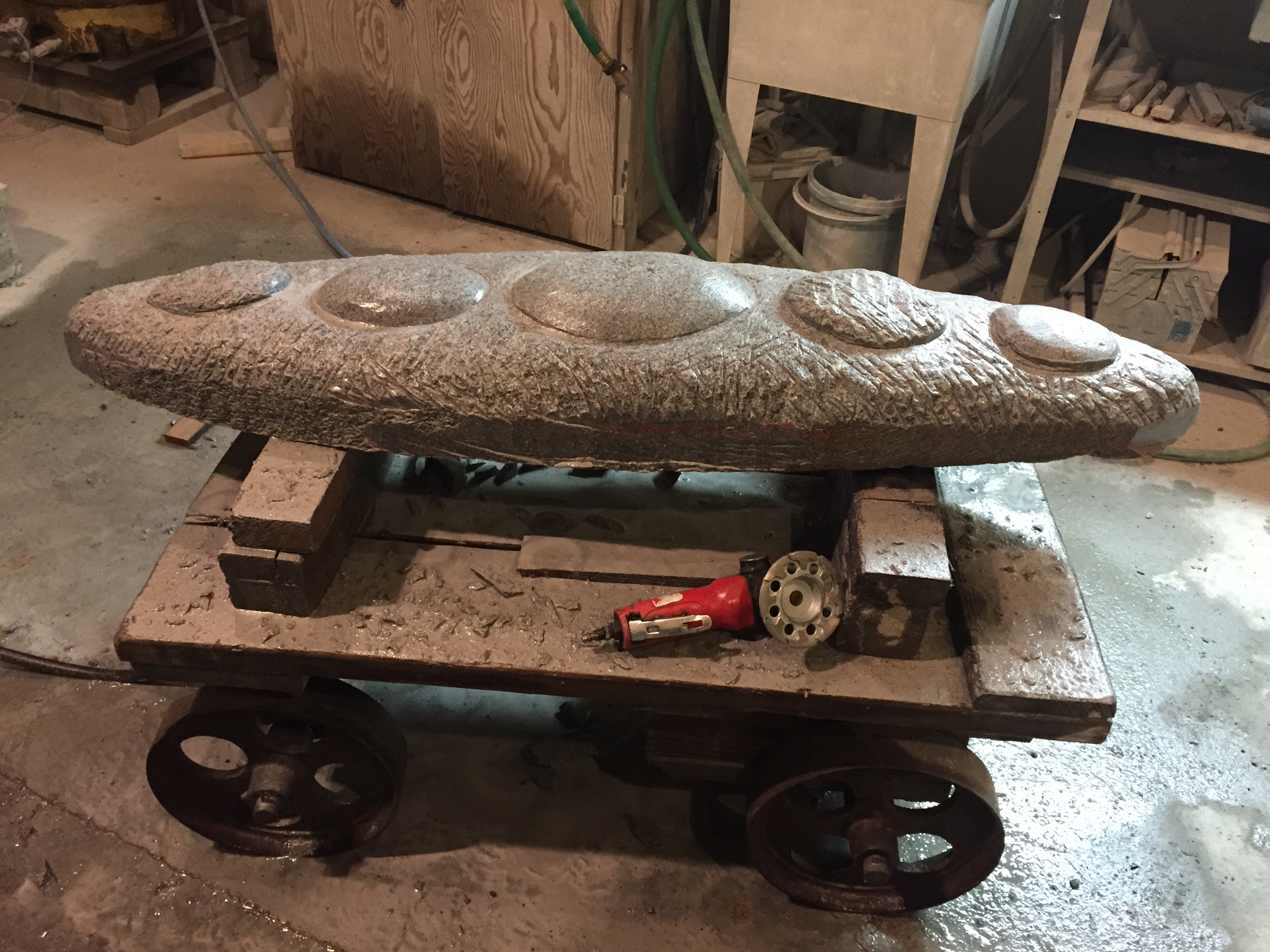
Indoor Galleries
Hortus Sublimis (The Secret Garden)
Kimberly J.B. Smith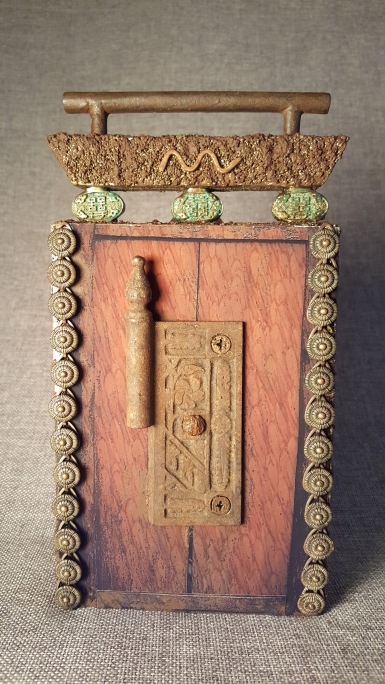 This little sculpture has two facades and both were inspired by two examples of East meeting West. The side with the brown door was photographed in a town in New Hampshire. The door leads to a private garden and has a dragon carved on the top.This door was clearly inspired by Eastern traditions, yet made its home in New England. After photographing the door, I cropped it, keeping the lovely wood grain and adding a number of metal embellishments to give this side a peaceful countenance.
This little sculpture has two facades and both were inspired by two examples of East meeting West. The side with the brown door was photographed in a town in New Hampshire. The door leads to a private garden and has a dragon carved on the top.This door was clearly inspired by Eastern traditions, yet made its home in New England. After photographing the door, I cropped it, keeping the lovely wood grain and adding a number of metal embellishments to give this side a peaceful countenance.
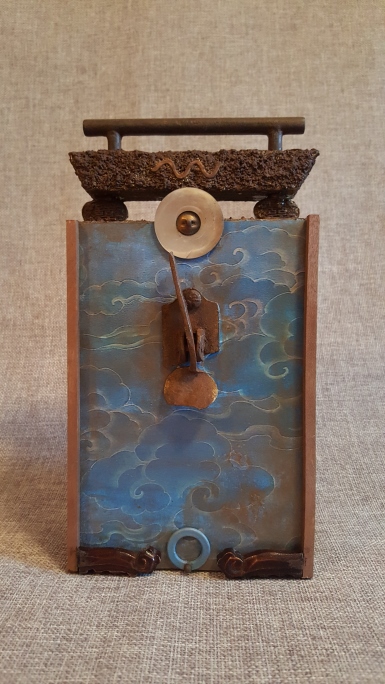
The blue side was photographed from a lovely scroll that was given to me by a friend. She was given the scroll by a family member who had traveled to Eastern regions. I am grateful for the gift and photographed a small area of the large scroll, essentially cropping the section digitally. The blue image was weathered, by me, to blend quietly into the composition. Details include vintage appetizer fork handles, an earring part, an antique door latch and a button.
The top of this two sided gate is composed of a door handle and is inspired by the traditional Japanese Torii gate. Upon entering the the gate, one is believed to transition from the mundane to the sacred.
This sculpture is a conglomeration of separate elements. Together, they create a new reality. We all come from different realities. I believe we can respect and honor each other. If we do, we too, can transition from the mundane to the sacred. Thus, this secret garden is revealed as a solution to the dissention so readily apparent in today’s world.”
Sea Dance
Maria Luongo
 “My sculpture Sea Dance was inspired by the sea and shell forms. It attempts to capture the feeling of movement of the waves and the forms of shells. It was chrome-plated to further enhance the feeling of water, giving it a liquid-like quality. When completed the two forms seemed to dance alive.This sculpture is a continuation of my exploration of the beauty, power and mystery of the sea.The photo at right shows me working in the studio on another of my sea oriented sculptures, Homage to the Sea, painted bronze.”
“My sculpture Sea Dance was inspired by the sea and shell forms. It attempts to capture the feeling of movement of the waves and the forms of shells. It was chrome-plated to further enhance the feeling of water, giving it a liquid-like quality. When completed the two forms seemed to dance alive.This sculpture is a continuation of my exploration of the beauty, power and mystery of the sea.The photo at right shows me working in the studio on another of my sea oriented sculptures, Homage to the Sea, painted bronze.”
Stalemate
Cindy Journey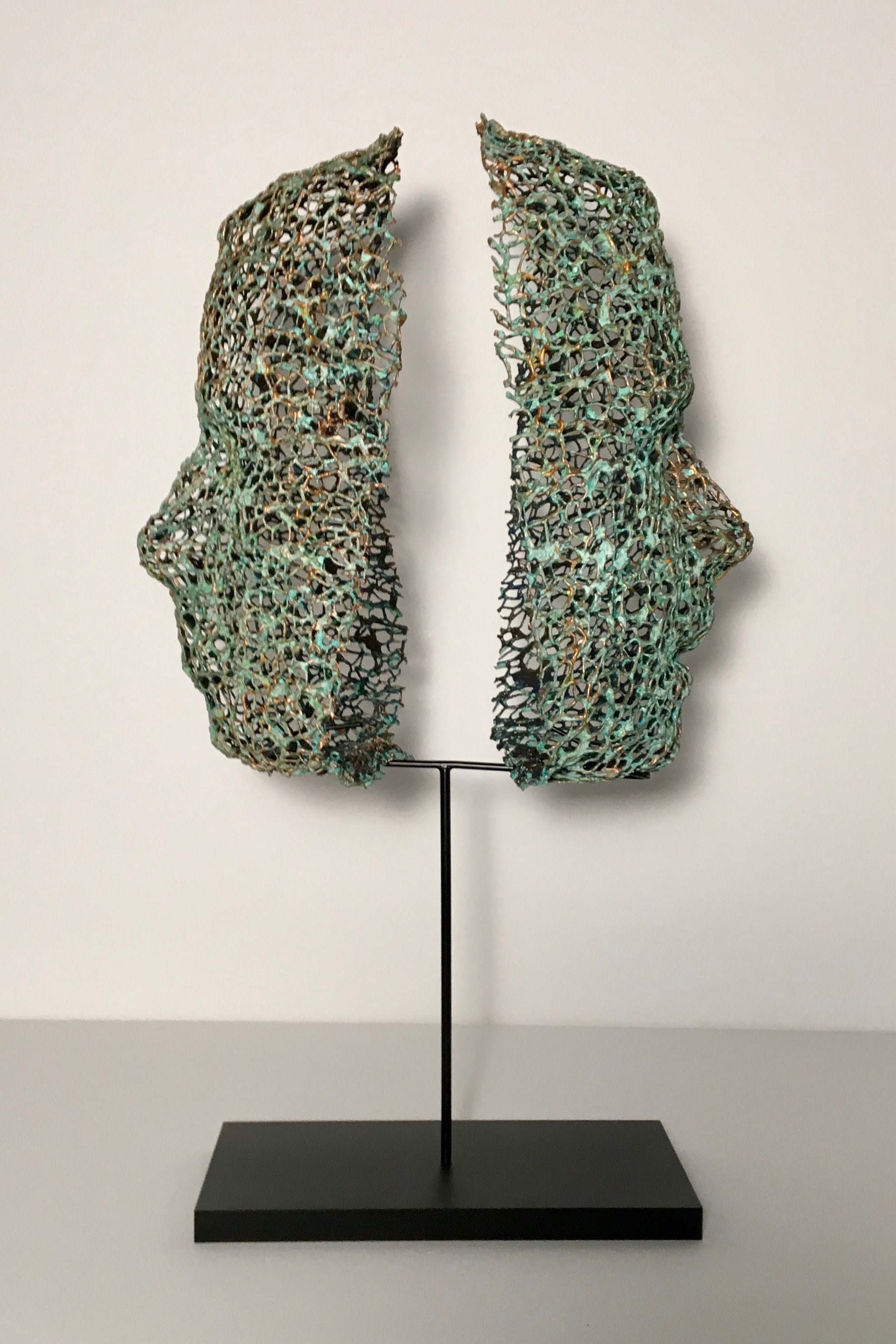 Cindy Journey’s unique sculptural style started with a failed attempt at knitting a scarf. The self-declared “lousy knitter” liked the effect of the random dropped and added stitches and thought this abstract knitting could be turned into something new.
Cindy Journey’s unique sculptural style started with a failed attempt at knitting a scarf. The self-declared “lousy knitter” liked the effect of the random dropped and added stitches and thought this abstract knitting could be turned into something new.
For Stalemate, Cindy knit an abstract shape using paper wrapped in Japanese silk thread. It was then shaped and treated with copper paint to create an effect that looks like wire or cast copper.
The artist described the inspiration behind this piece: “I created this piece after the 2016 presidential election. We have all witnessed the stark division in the State of Our Union. This sculpture represents how we are currently unwilling to listen to each other, work together, or see one another’s perspectives. Empathy and collaboration seem to have all but disappeared, not only from government and the media, but also our society more broadly. In a stalemate, there is no progress and no one wins.”
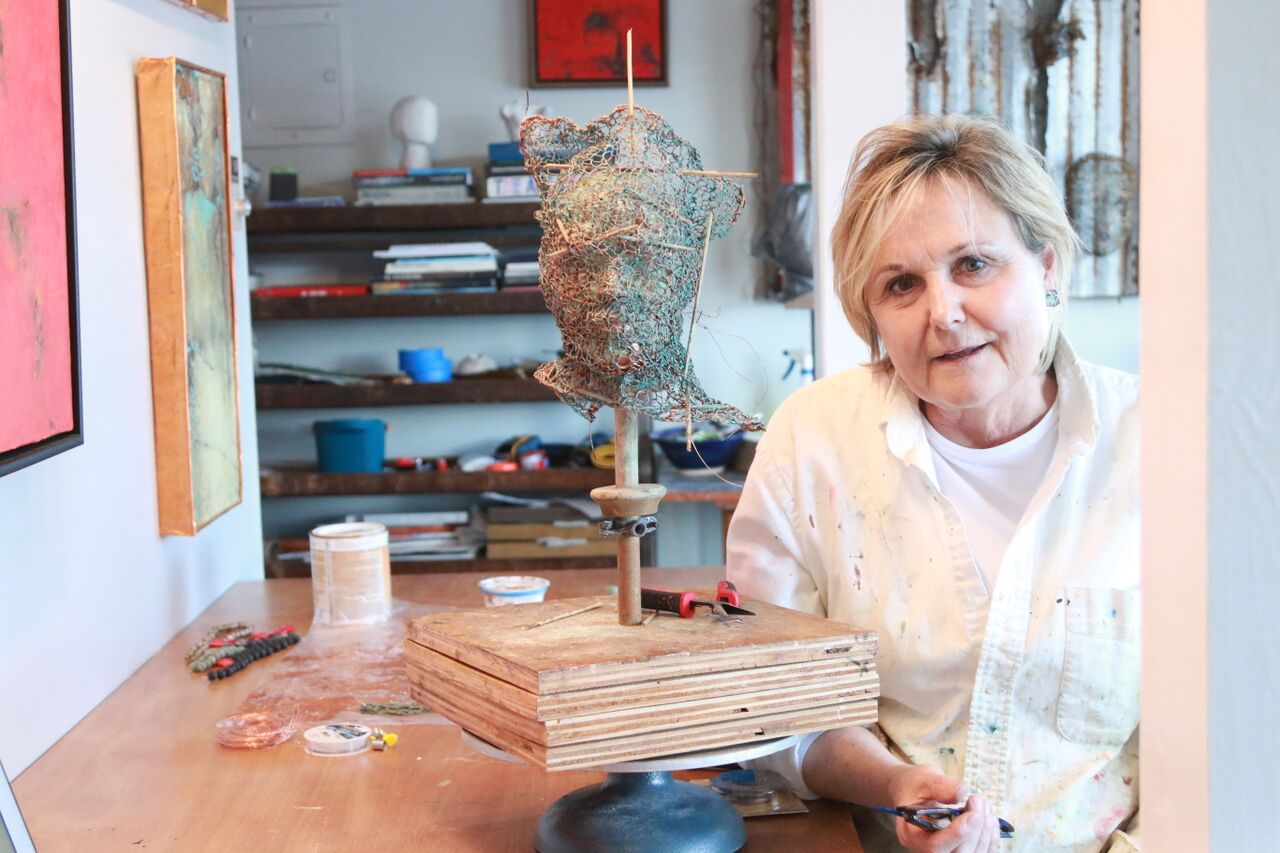
Crosscurrents
Carolyn Enz Hack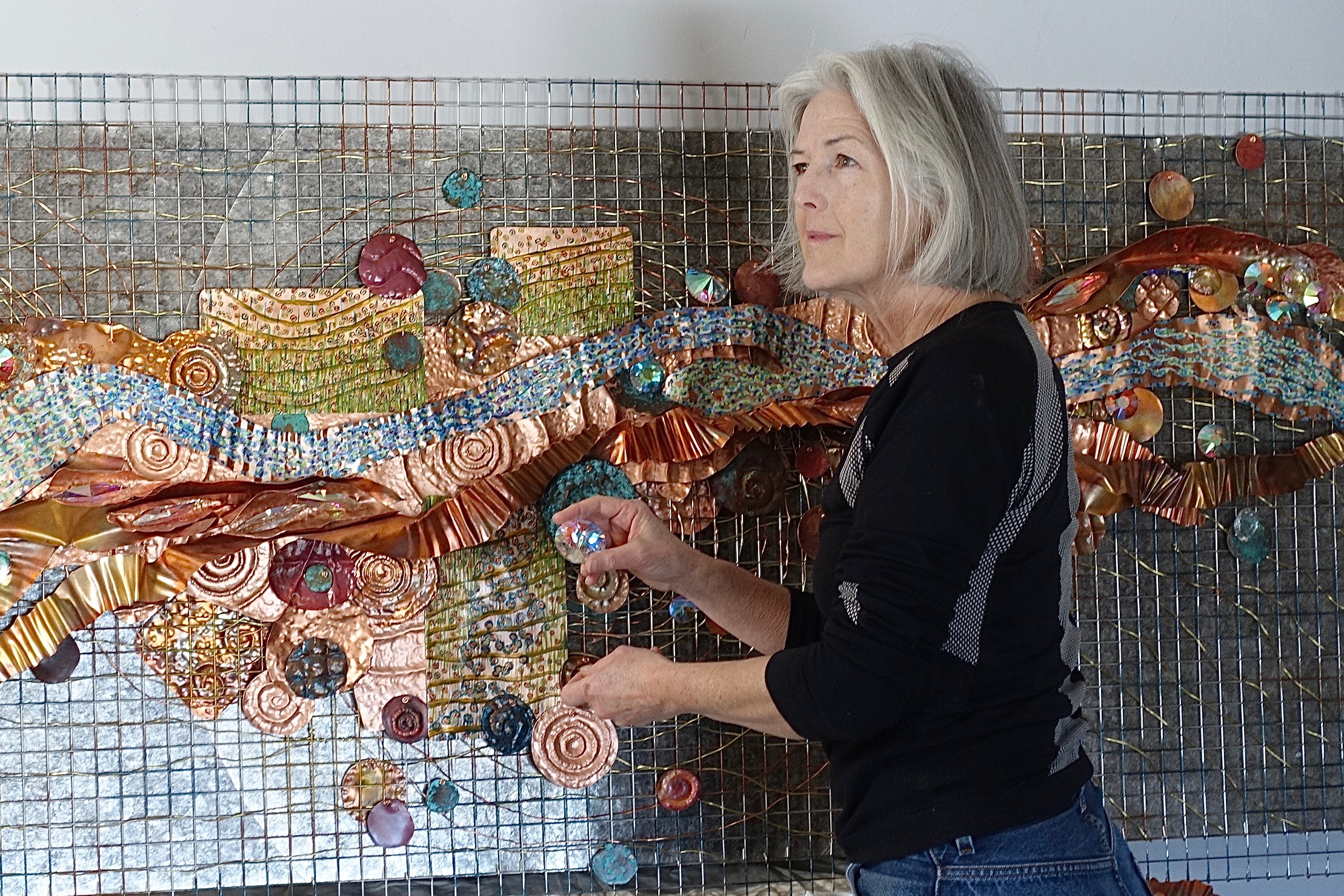 Sculptor Carolyn Enz Hack used a variety of media to create Crosscurrents, including copper, steel, mica, and Swarovski crystals. She says the piece is “inspired by the way that water moves through a landscape… All experience of the world is sifted through the lens of time. My work, at a basic level, is about our relationship to space and time, how we experience the environment through our senses and in memory. There’s a saying that you can’t jump into the same river twice, because time brings a different river every second. Crosscurrents is my attempt to hold that river still, if only for a few moments.”
Sculptor Carolyn Enz Hack used a variety of media to create Crosscurrents, including copper, steel, mica, and Swarovski crystals. She says the piece is “inspired by the way that water moves through a landscape… All experience of the world is sifted through the lens of time. My work, at a basic level, is about our relationship to space and time, how we experience the environment through our senses and in memory. There’s a saying that you can’t jump into the same river twice, because time brings a different river every second. Crosscurrents is my attempt to hold that river still, if only for a few moments.”

Watch the video below to hear more about the artist’s process and inspiration in her own words, plus see the artist at work in her studio.
Piscinus plasticus
Alan Weinstein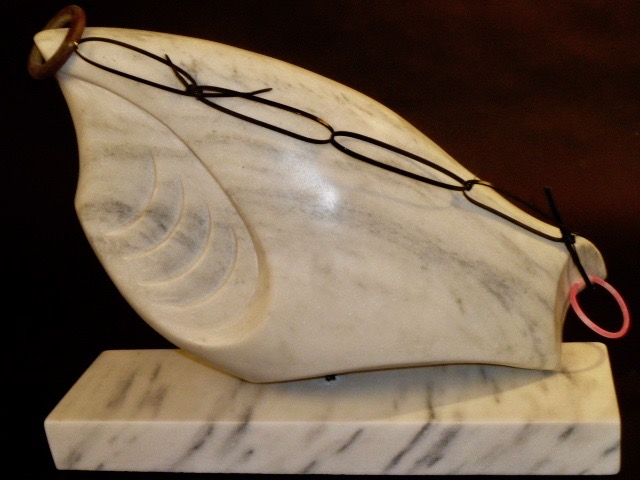
“It’s been estimated that 18 billion pounds of plastic waste end up in the world’s oceans. That could equal five grocery bags of plastic waste for every foot of coastline on the planet. As much as 1 million animals die as a result of this, not to mention various health ailments incurred by humans. Regardless of the statistics, the problem is real, it is disgusting, and it is another salient example, along with climate change, that we are not paying heed to scientists and we are not treating our planet with the respect it deserves.
So, I regret that the theme of “changing landscapes” at the Eustis Estate conjures up this negative image for me and leads me to display Piscinus plasticus. Aside from the plastic rings that have entangled the piece, you may notice the exaggerated gills which may evolve in time to more efficiently absorb the decreased oxygen levels in the water. What will it take to compel all of us to take our environmental challenges more seriously while there is still time, or has our environment changed irreparably already?” – Alan Weinstein
Rebirth
Cassie Doyon“Roughly ten years ago, I was kayaking with my husband and children on Wellfleet harbor. We landed on Great Island where my son discovered some whale bones. We collected the bones and my son brought them for show and tell at school the following week. The bones then sat in his closet for the next ten years. I was inspired to honor those bones and create something with them. The sea resonates deeply within me, as I was born and raised in Gloucester, Massachusetts and most in my family were involved in the fishing industry. As a child of the 1970s, the need to reuse and recycle was a value instilled in me which is reflected in my artwork to this day. Natural and recycled materials such as sea glass and driftwood has become a recurring theme in my work. Rebirth celebrates and honors the life of a sea creature; part of that animal has gained immortality through transformation, reincarnation and reconstruction into a work of art.” – Cassie Doyon
Derrick TePaske
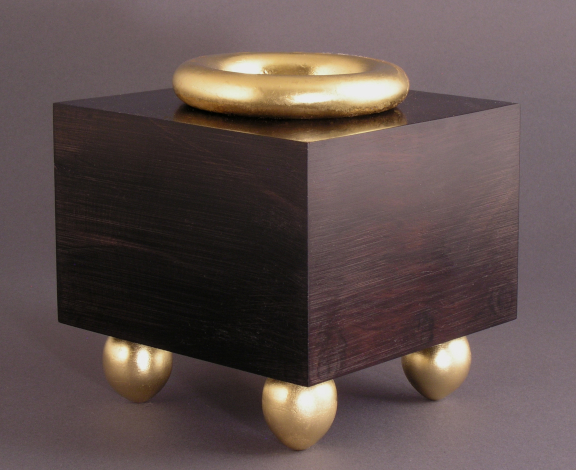
Derrick TePaske has three pieces in the show, which all draw upon the are of the past and honor ancient artists who came before him. Here’s his statement on the works:
“As a professor of media studies, I am primarily concerned with theoretical principles and digital production methods. In purposeful contrast, my art involves wood and other common materials, employs tools and processes which are decidedly low tech, and results in unique and very tangible objects. I have always been interested in classical forms, the ancient, the primitive, and the strange. I sometimes joke that “the older I get, the older the art that I love.”
The Reliquary Furcula: A Shrine to Wishes was the first of a group of pieces I am currently working on, which relate to reliquaries and ossuaries, traditions which have existed in various cultures for many centuries, and for reasons both religious and secular.
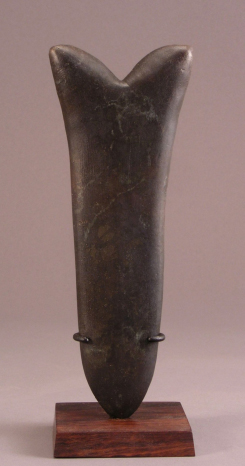
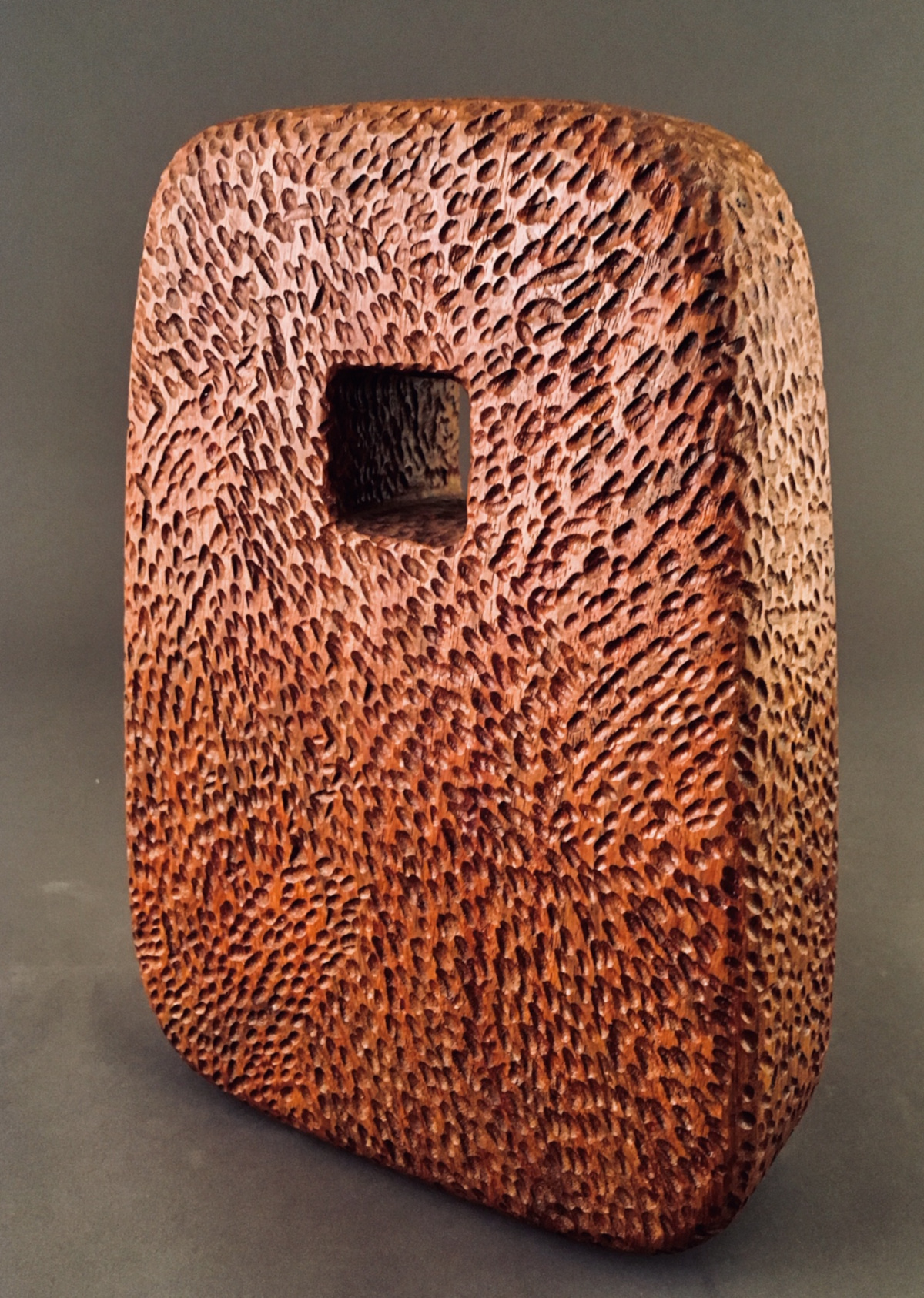
Homage: Knife is a cast bronze version of an ancient Egyptian pesh-kef knife, one of the earliestknown specialized medical instruments. Originally stone blades with handles, and dating from about 4000 BCE, they were originally used to cut a newborn’s umbilical cord. Later, in stylized form and as part of another sort of “birthing,” they came to be used in “opening of the mouth” burial ceremonies, which allowed the deceased to eat and drink again in the afterlife.
Homage: Anchor takes its form from the large stone anchors recovered in the early 1980’s off the coast of Turkey from the wreck of the Uluburun, the oldest shipwreck ever recovered, and dating from about 1300 BCE. This African rosewood version is one of three I have made; another is life-sized at about 24” tall and made of ebonized elm; the third, at 6 inches tall, is a cast bronze miniature (but at least it will sink, like a respectable anchor).
